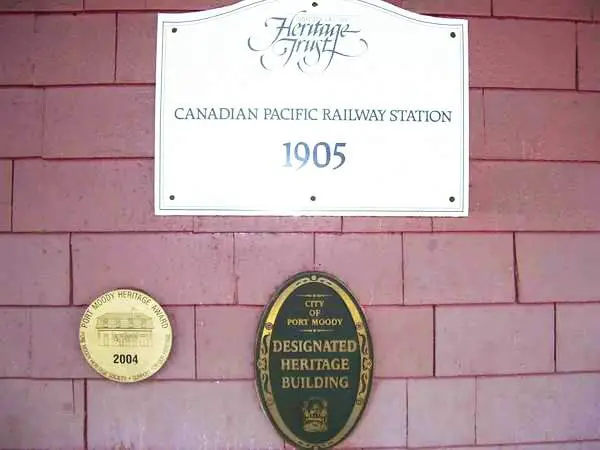 |
|
Corey Walker, Prince George, BC |
Canadian Railway Artifacts
| One of my visitors suggested that I start a page on
railway artifacts.
Like all my pages I ask if any visitor has any pictures that will suit this site to please send them to me. to be included on this page. Also if you can idenify or correct any pictures on this page please do so. johnmacdoanld@summerville-novascotia.com |
 |
|
Corey Walker, Prince George, BC |
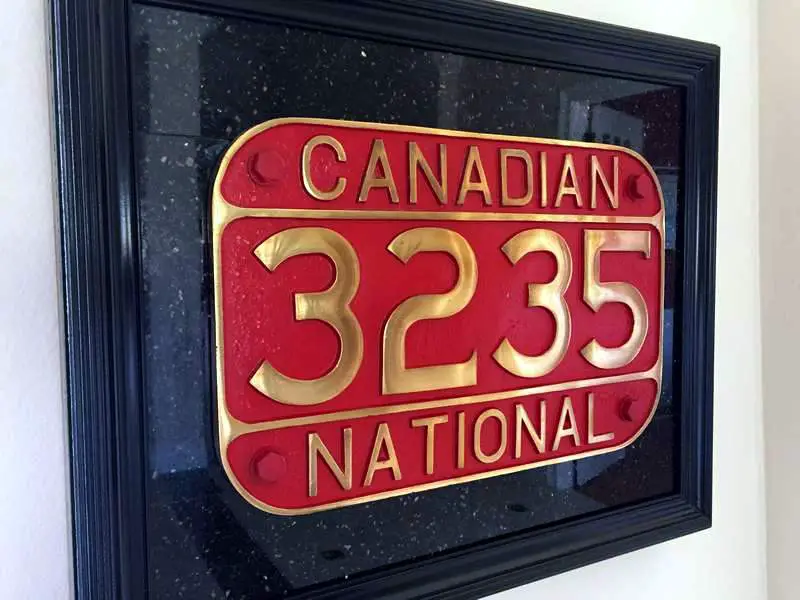 |
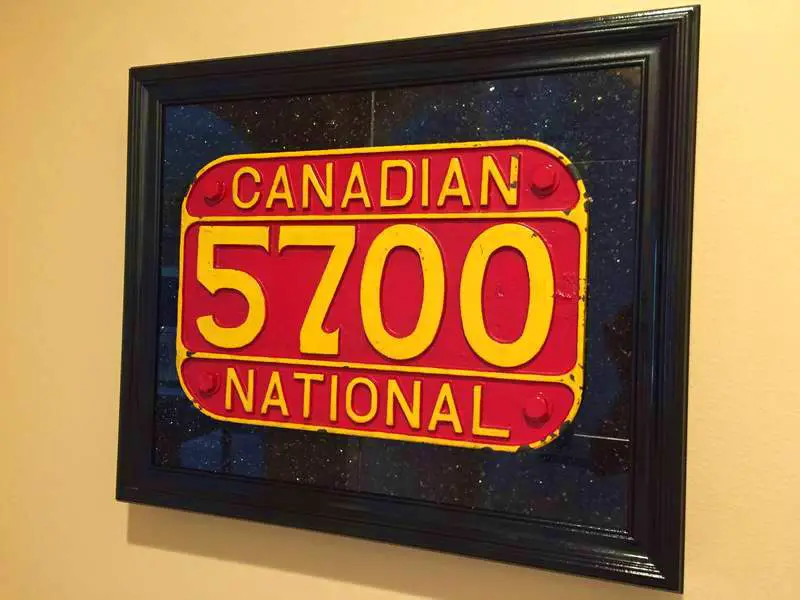 |
|
|
| This picture of the item (Paris Express ) was submitted by Jim Booth,
Willingdon AB
Jim purchased it a long time ago when he was in the military. It is lettered the same on both sides, with one side showing more previous polishing than the other. He doesn't know if it is from a French train or not, and every time he sends a message to a RR museum in France he never get a reply. We were wondering if any of my visitors can shed some light on what it may be. |
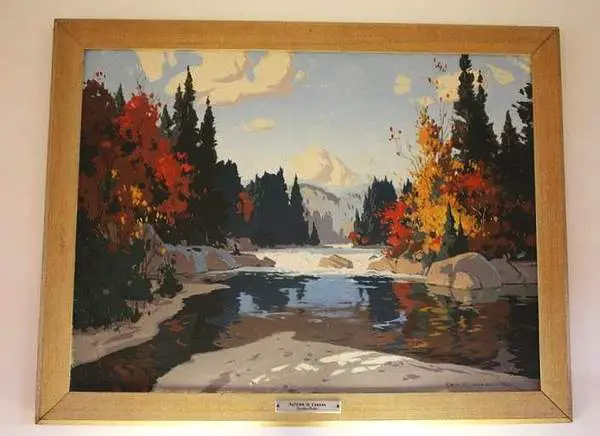 |
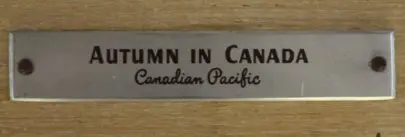 |
| This picture was submitted by Jim Booth, Willingdon AB. It shows
the CP print of "Autumn in Canada" and is hanging on the wall over his
fireplace.
It was being thrown in the garbage and he grabbed it. |
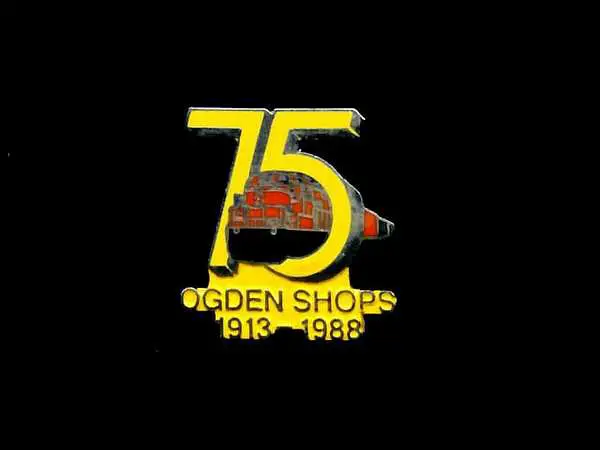 |
| The official commemorative pin issued to employees and guests for
the 75th anniversary of the CPR Ogden Shops in 1988. Ogden Shops, located
at 7550 Ogdendale Road S.E. Calgary, Alberta. The pin is 25mm high x 25mm
across (1” x 1”)
While the shops are now managed by Alstom Transport in order to consolidate overhaul services for freight cars, locomotives and components, Canadian Pacific Railway Headquarters will now also be on the property, following a move from downtown Calgary. View extensive coverage of the Ogden Shops, its history, buildings
and several photos of past top echelons at http://www3.telus.net/hildavid/Ogden/.
Some employees are seen unveiling the anniversary flag in front of "Spike"
(the large metal man) featured at the
|
| Massey F. Jones collection |
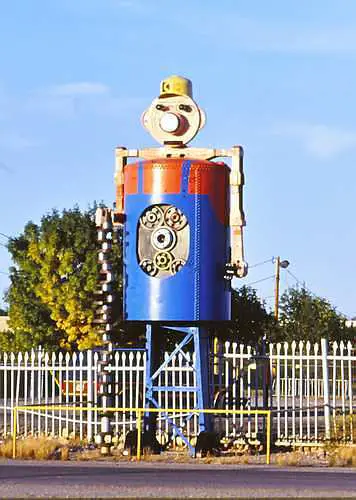 |
| This picture was taken and submitted by Massey F. Jones |
|
acquired an Elgin, private-label pocket watch. He has a collection of about 140 of them covering from Victoria BC to Prince Edward Island |
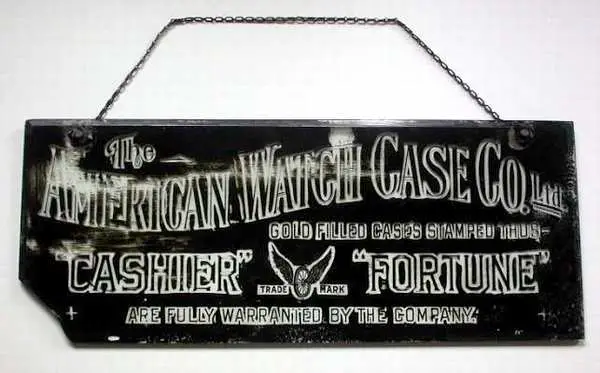 |
10" X 20" plateglass advertising sign from The American Watch Case Co. featuring their "Cashier" and "Fortune." gold filled cases with their Winged Railway Wheel Trademark emblem. |
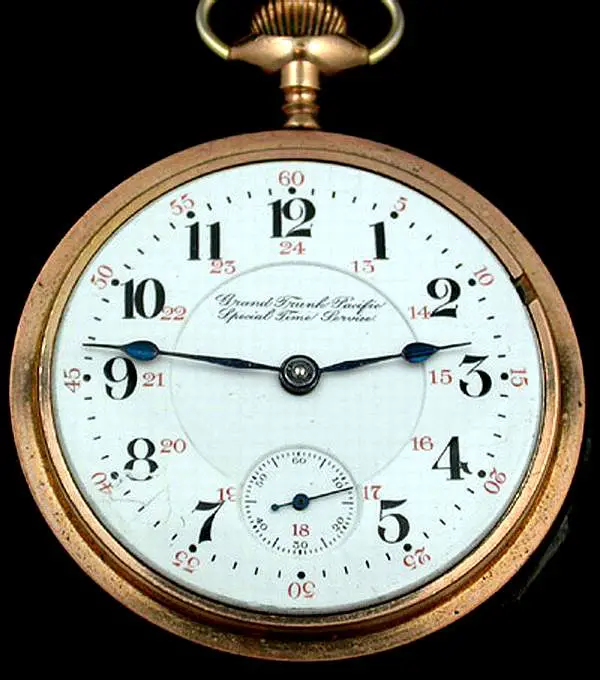 |
Railway approved Hamilton 18 size, 21 jewel, Grade 940, private-label pocket watch marked "Grand Trunk Pacific Railway Time Service" |
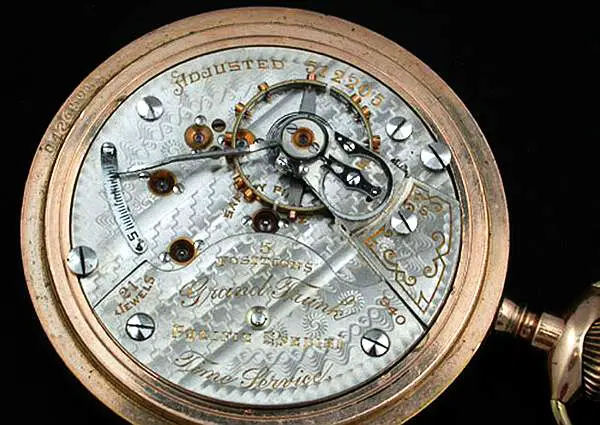 |
Railway approved Hamilton 18 size, 21 jewel, Grade 940, private-label pocket watch marked "Grand Trunk Pacific Railway Time Service" |
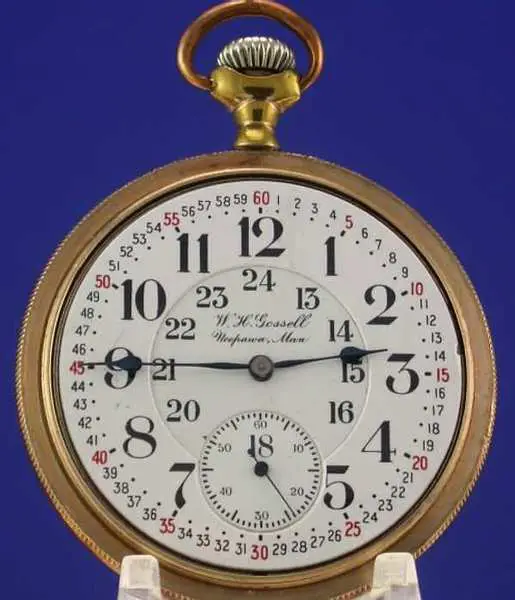 |
An Elgin, private-label pocket watch, private-label's were very
popular around the turn of the 20th century where jewelers, and watchmakers
to get there name and
community on the dial of the watch, and sometimes on the movement |
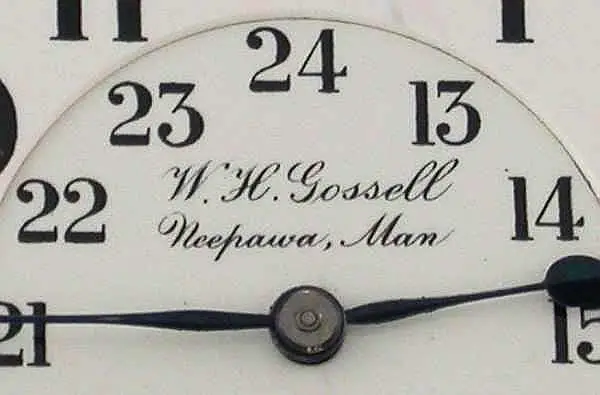 |
Private-label, double sunk, bold Arabic 24-hour,
Montgomery dial marked "WH Gossell, Neepawa, Man" |
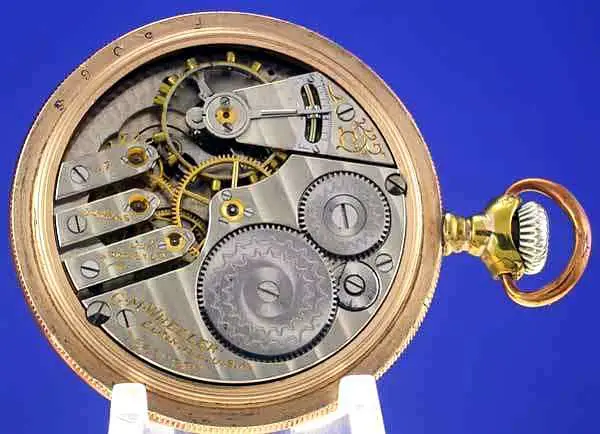 |
Movement Elgin 16 size, 17 jewel, Grade 291,
GM Wheeler, Model 7, Serial No. 15367887, Manufactured 1910, Pendant Set, Three fingered bridge movement, signed GM Wheeler |
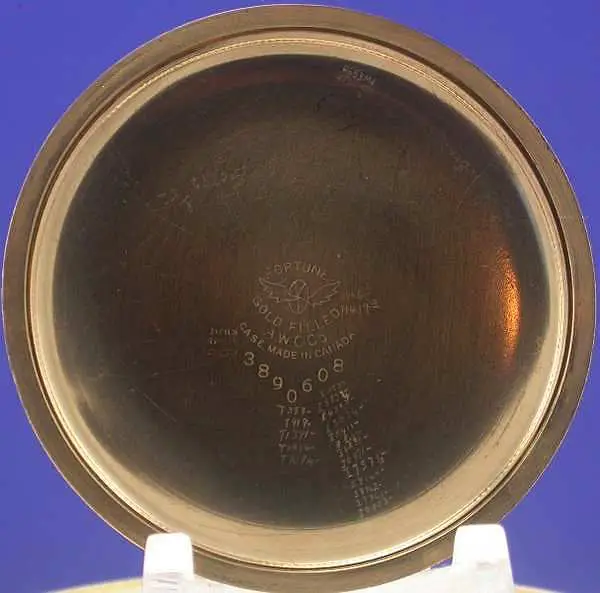 |
Cased in American Watch Case Co. screw back
and bezel yellow gold filled Fortune case |
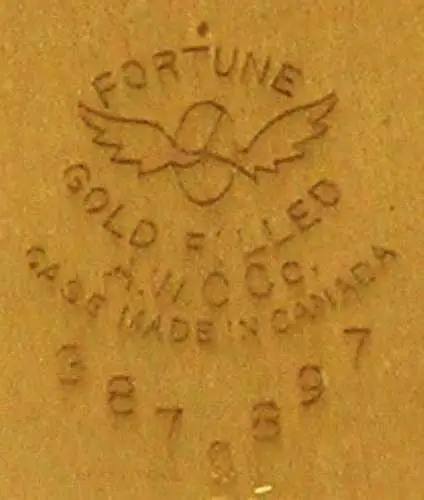 |
Winged Railway Wheel Trademark emblem |
|
These watches are all from the Matitime Provinces. |
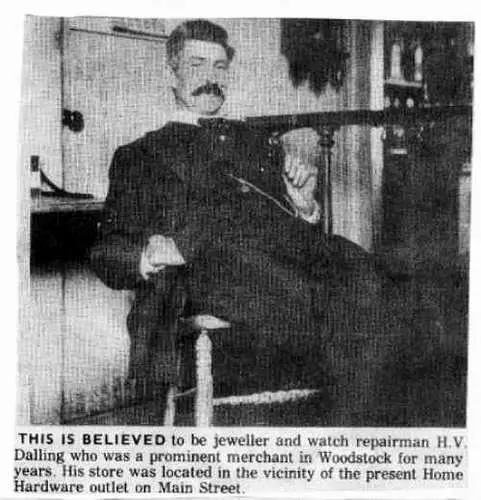 |
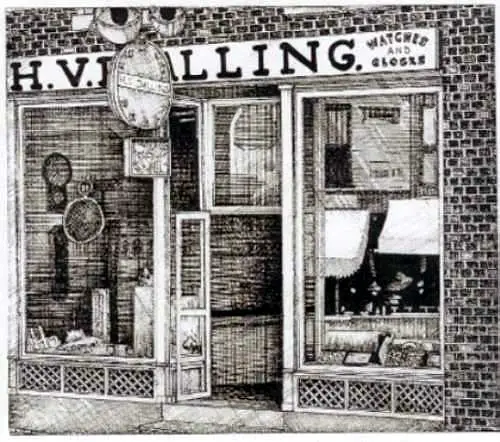 |
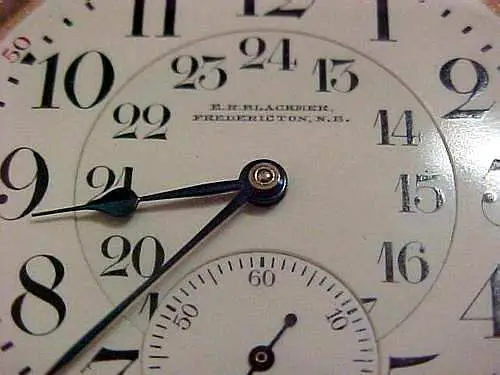 |
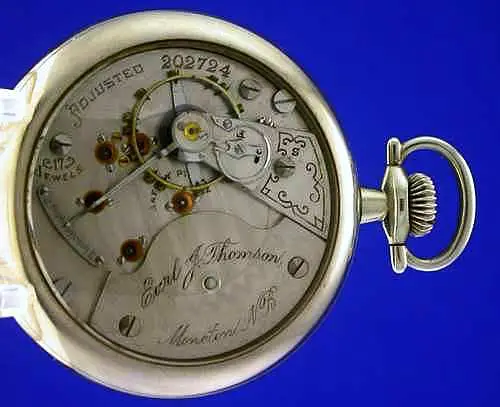 |
| 1892 ER Blackmer, Fredericton NB CPR Waltham 17 Jewel Dial | Ledgers show that they were all sold to the Montréal Watch Case Co. on April 30, 1904 and that this watch was Finished June 25, 1902 it has a private-label dial & movement marked Earl J. Thompson, Moncton, NB (New Brunswick) Serial # 202724 |
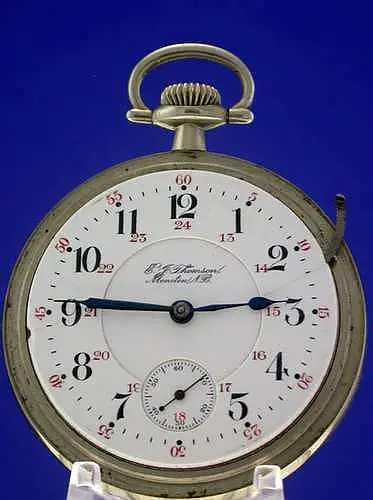 |
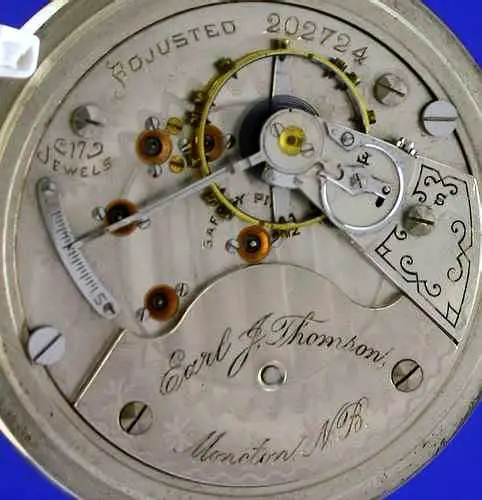 |
| Hamilton 18 size, 17 jewel, Grade 934 Serial No. 202724
from a run of 6 Hamilton Pocket Watches Serial No. 202721 to 202726 the
Hamilton
Watch Factory Co. |
Close-up of movement marked Earl J. Thompson, Moncton, NB
Serial Number 202724. 1902 private-label movement marked Earl J. Thompson, Moncton, NB (New Brunswick) it would be nice to find one of the other ones in this run of 6 private-label in particular 202725 that would give me three in a row |
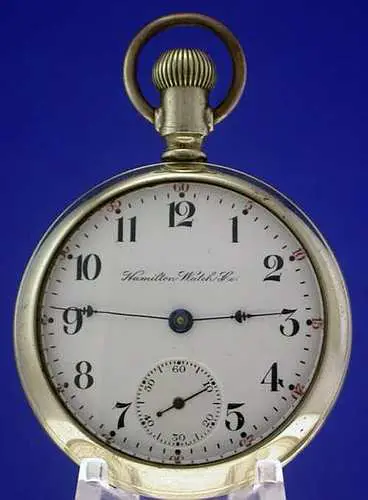 |
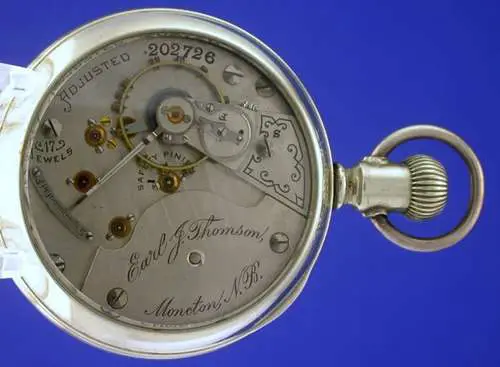 |
| Hamilton 18 size, 17 jewel, Grade 934 Serial No. 202726
Date finished June 7 |
Hamilton 18 Size 17 Jewel Grade 934 Private Label Earl J Thompson Moncton NB Movement, Serial # 202726 |
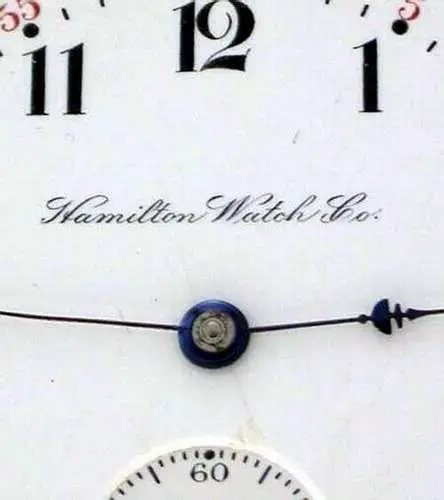 |
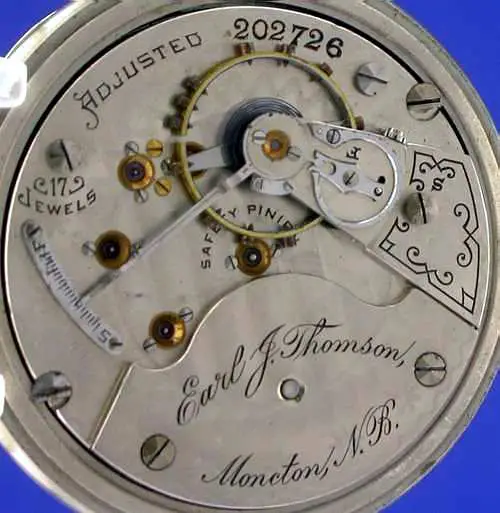 |
| Hamilton 18 size 17 Jewel Grade 934 Hamilton Watch Co.
Arabic Single Sunk Dial |
Hamilton 18 Size 17 Jewel Grade 934 Private Label Earl J Thompson Moncton NB Movement, Close Up, Serial # 202726 |
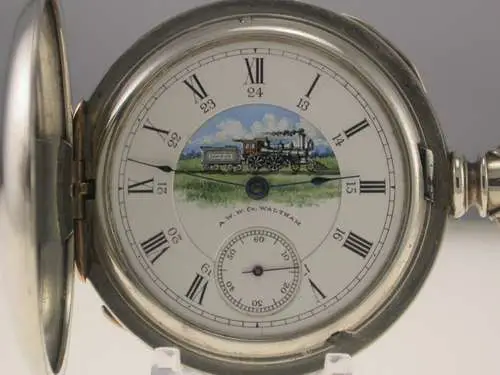 |
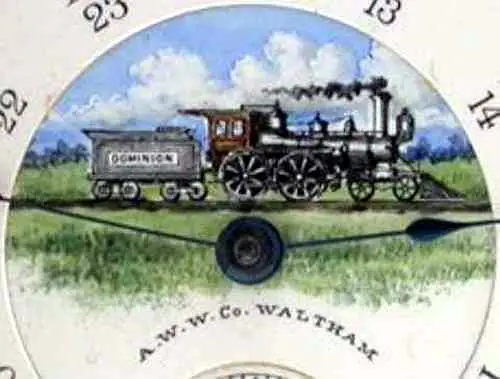 |
| Waltham 18 size, 15 jewel, Model 1883, Serial No. 3837324, Manufactured 1888, private-label dial Dominion movement Dominion Railways I believe these watches were ordered for the Dominion Atlantic Railway, years ago I saw a private-label listed on a dealers publication of watches for sale, it was an 18 size, 17 jewel, adjusted gilt 1883, movement No. 5280607 this one had a private-label dial marked "B.L.Reagh, watchmaker and jeweler, Middletown, N.S. | Note the hand-painted American style 4-4-0 steam locomotive with the pastoral background and DOMINION is written on the tender, they made dials like this for the CPR |
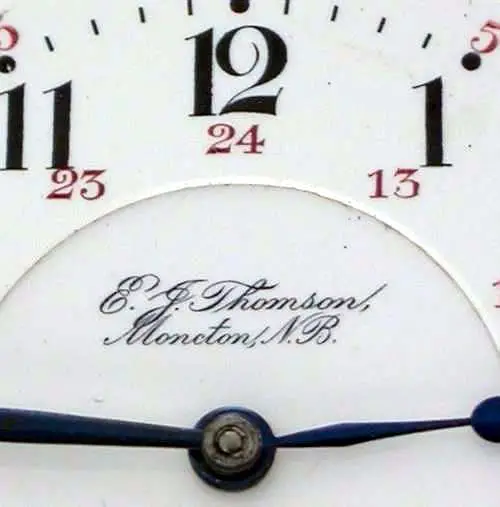 |
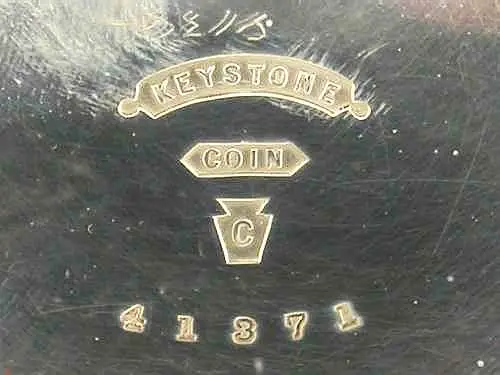 |
| Hamilton 18 size 17 Jewel Grade 934 Private label Earl J Thompson Moncton NB Dial Close-Up | Waltham Dominion Railways Coin Silver Trademark, Close-Up |
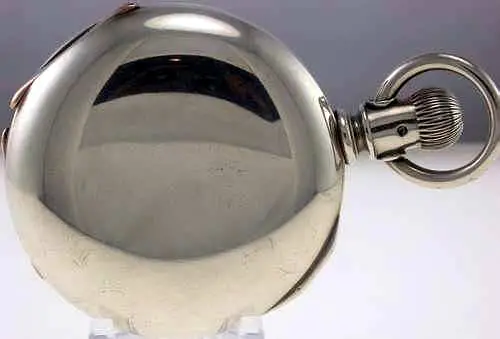 |
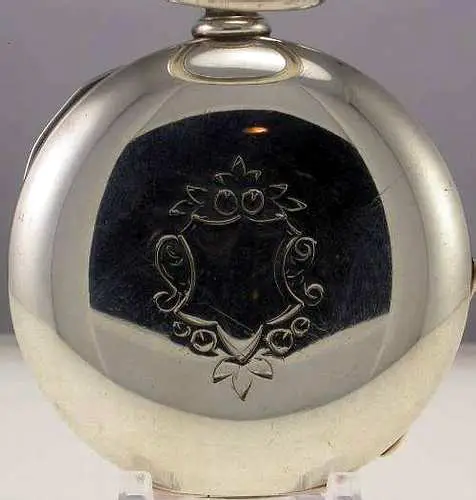 |
| Waltham Dominion Railways Silver Case | Waltham Dominion Railways Case Back |
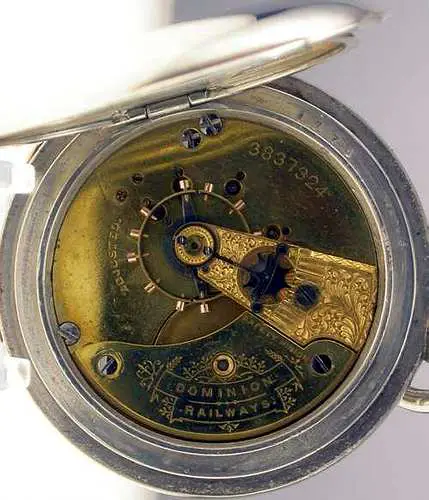 |
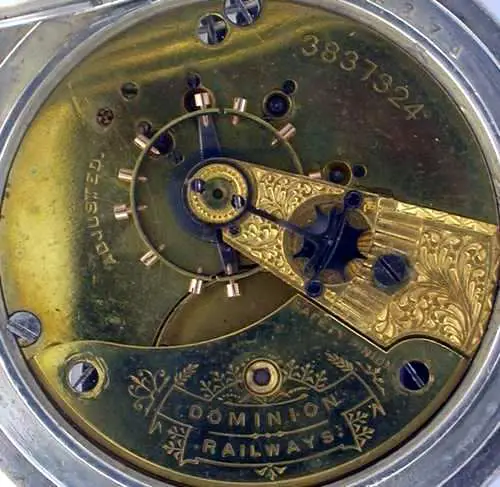 |
| Model 1883, Serial No. 3837324 Movement | Model 1883, Serial No. 3837324 Movement, Close-up |
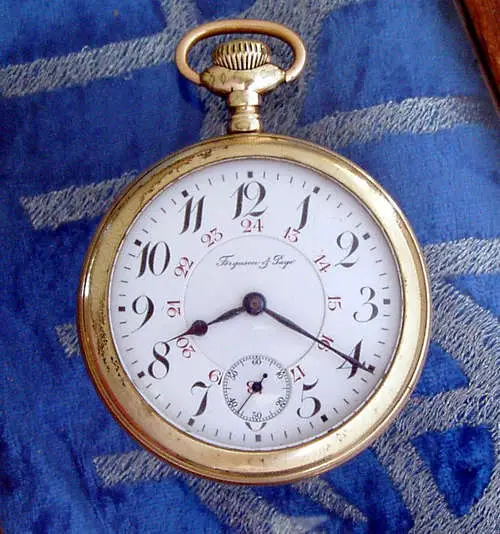 |
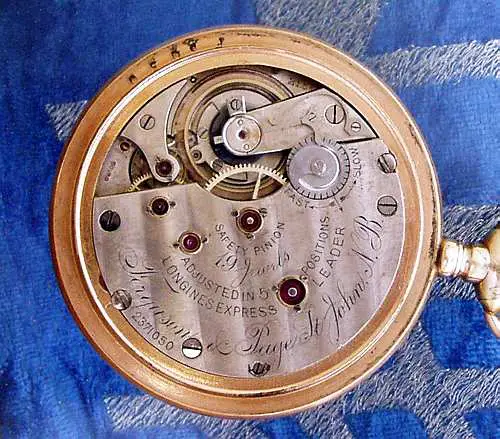 |
| Longines 18 size, 19 jewel, Grade Express Leader, Serial No. 2371050 Manufactured 1907. | Private label dial and movement marked Ferguson and Page St. John NB |
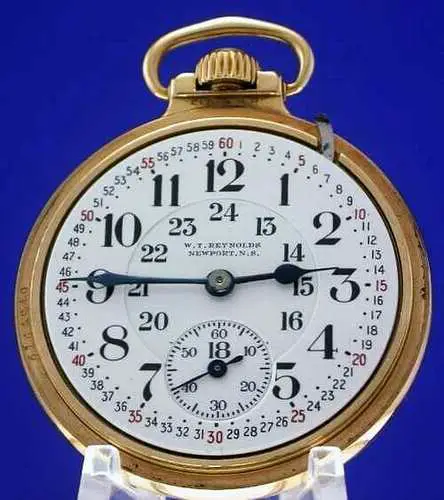 |
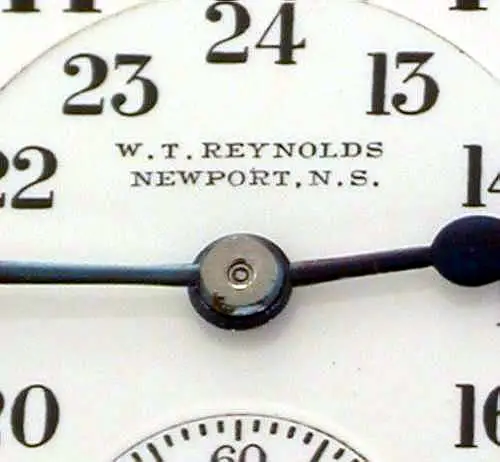 |
| Elgin 16 size, 23 jewel, open face, lever set, Grade Veritas Serial No. 15569502, Manufactured 1910. Private-label bold Arabic 24-hour Montgomery dial marked "W.T. Reynolds Newport, N.S." | Elgin 16 Size 23 Jewels, Private Label Dial WS Reynolds., Newport NS |
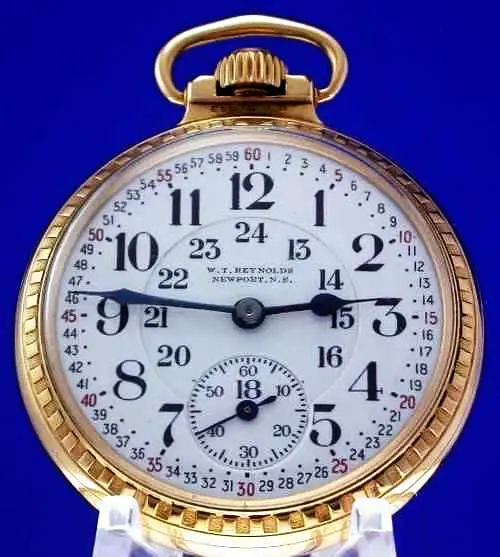 |
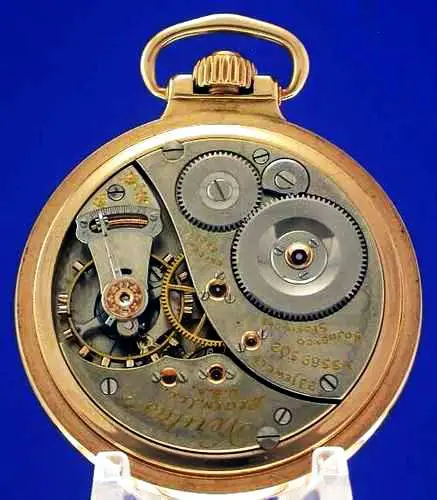 |
| Elgin 16 Size 23 Jewels, Private Label Dial marked
WS Reynolds, Newport NS |
Elgin 16 Size 23 Jewel Grade Veritabas, open face, lever set movement Serial # 5569502 |
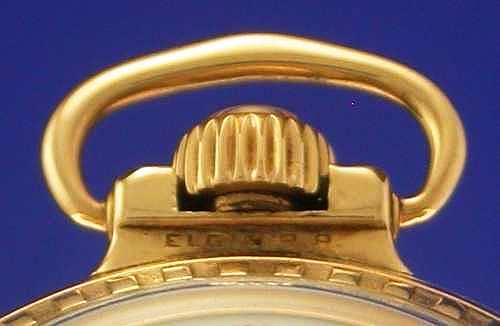 |
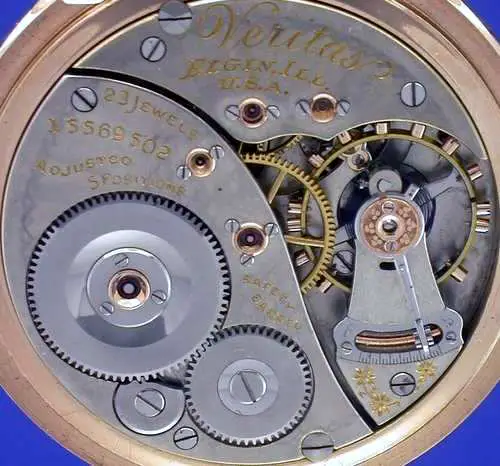 |
| Elgin 16 Size Case Marking Under Bow and Crown | Elgin 16 Size 23 Jewel Grade Veritabas, open face, lever set movement Serial # 5569502 Close-up |
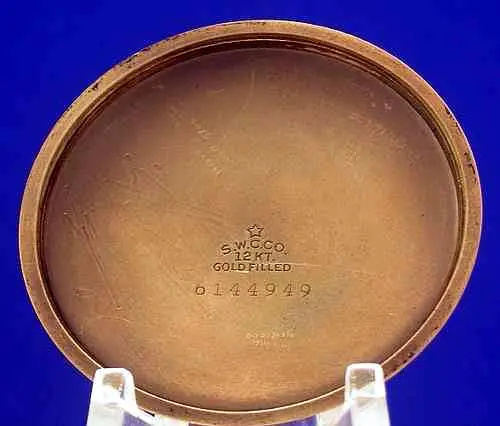 |
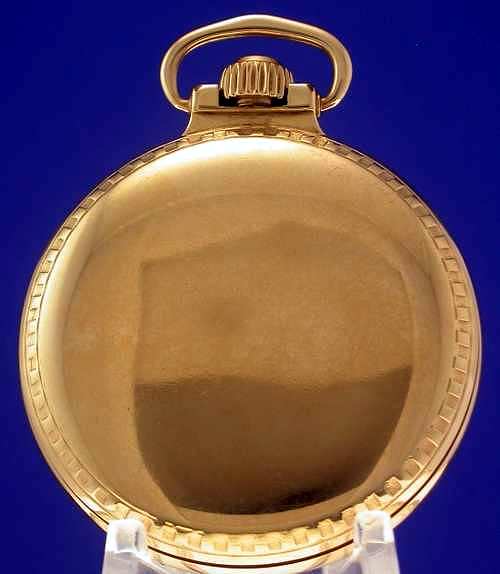 |
| Elgin 16 Size Inside Back Cover | Elgin 16 Size Star Watch Case Back |
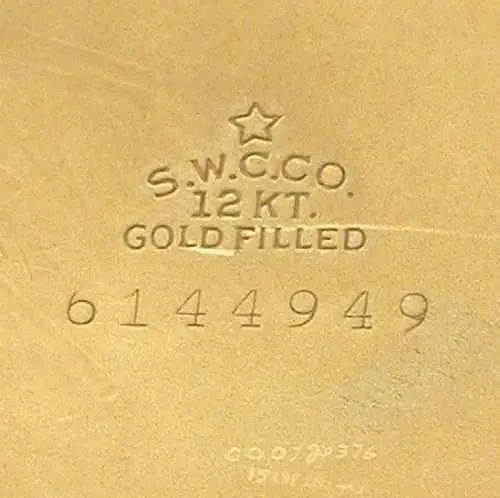 |
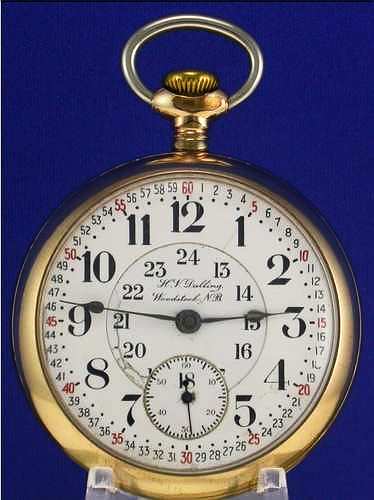 |
| Elgin 16 Size Star Watch Case.Trademark | Elgin 18 Size 19 Jewel Bwr Private Label showing HV Dalling,
Woodstock NB, Dial |
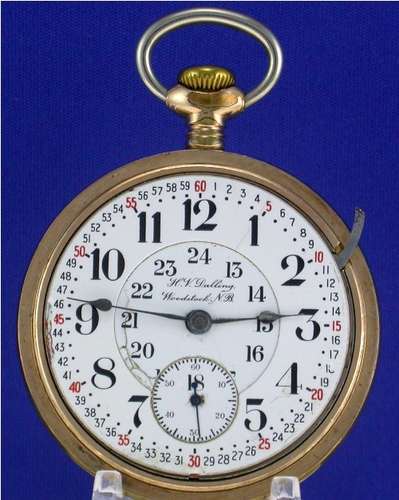 |
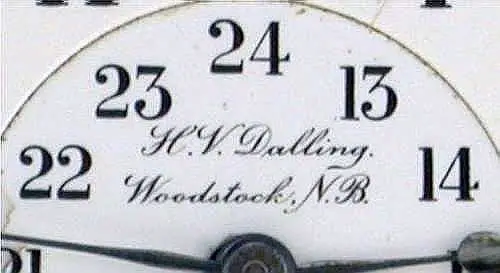 |
| Elgin 18 Size 19 Jewel Bwr Private Label showing HV Dalling,
Woodstock NB, Dial |
HV Dalling, Woodstock NB, Dial |
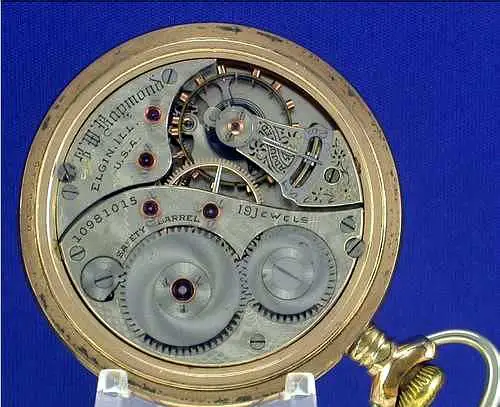 |
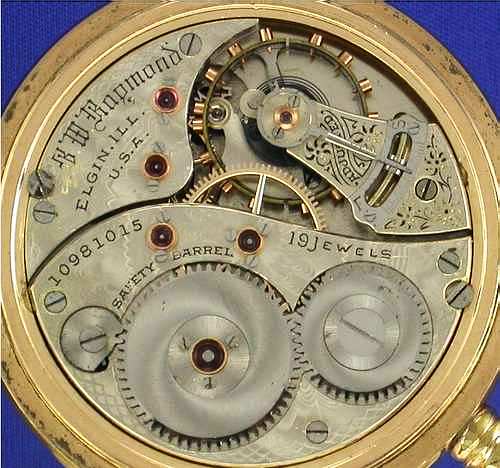 |
| Elgin 18 Size 19 Jewel Grade BW Raymond, Serial No. 10981015
NV Dalling Movement |
Elgin 18 Size 19 Jewel BW Raymond, NV Dalling Movement, Close Up |
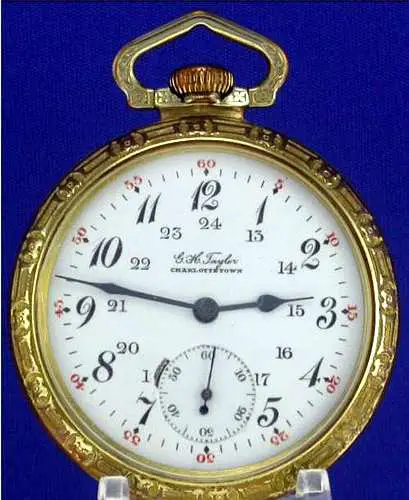 |
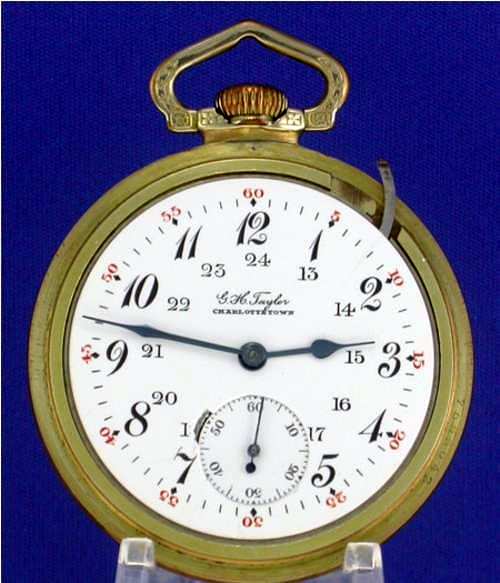 |
| Illinois 16 size 15 jewel Private Label SS 24hr Dial marked GH Taylor Charlottetown | Illinois 16 size 15 jewel Private Label SS 24hr Dial marked GH Taylor Charlottetown |
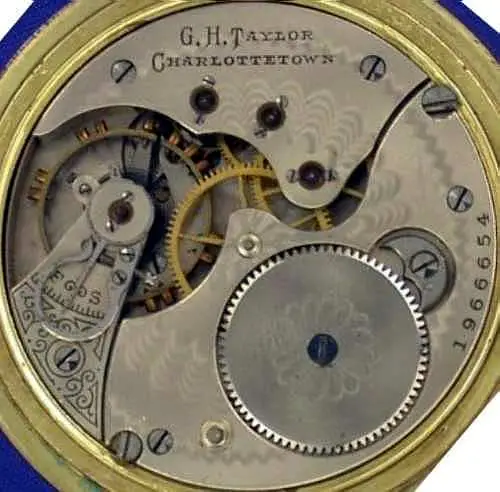 |
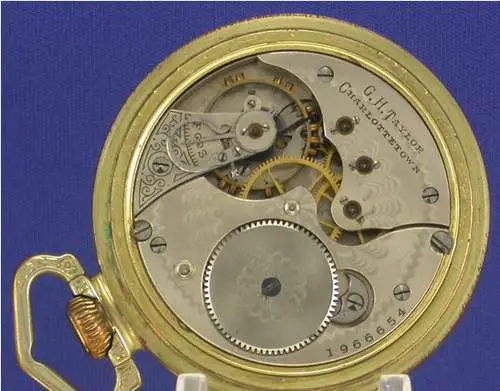 |
| Illinois16 size 15 jewel Getty Model Private Label marked GH Taylor Charlottetown, Close-Up_Movement | Illinois16 size 15 jewel Getty Model Private Label marked GH Taylor Charlottetown |
|
map showing lines between Brandon, and Portage la Prairie |
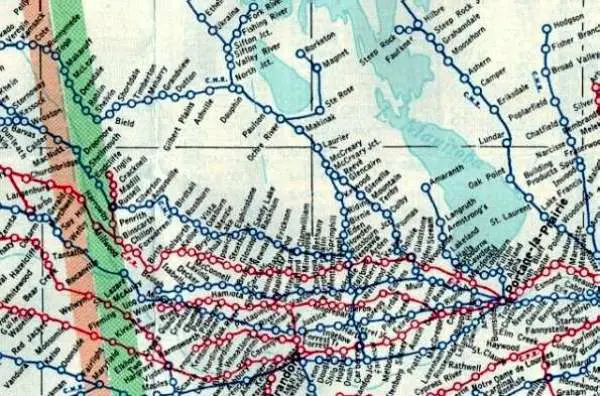 |
Canadian Pacific Railway Western lines map showing
lines between Brandon, and Portage la Prairie, Manitoba the red line is the CPR main line, Neepawa is on the red branch line above Portage la Prairie going to the left it is the seventh station on the branch line, Gladstone is the fourth. It also appears to have a Canadian National Railways (ex Canadian Northern Railway) branch line running north to south in blue, the line moved on to that runs westward, running through Kamsack, Saskatchewan, from Kamsack the line runs to North Battleford on the Alberta border where it runs to the provincial capital of Edmonton the section of track between Neepawa and McCreary junction was built in 1903 and between Grandview, Manitoba and Kamsack, Saskatchewan in 1904 and from Beaver to Gladstone, Manitoba in 1901. The station still exists on Fifth Avenue, on Hamilton Street. |
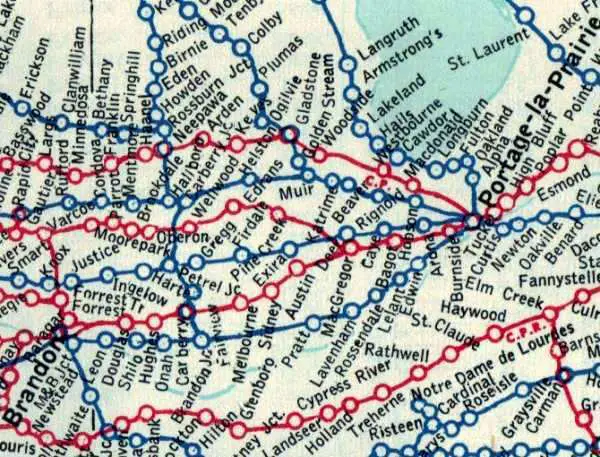 |
Neepawa name is derived from the Cree First Nations
word for "Land of Plenty" European settlers came here in the 1860s when Manitoba was still part of the North West Territories, Manitoba became the province in 1870 there was not much development of the village until the 1880s after the Manitoba and Northwestern Railway (which was leased to the CPR) line was built to Gladstone, Manitoba, local businessman John Davidson and Jonathan Hamilton offered the railway a land-grant and financial bonus of $16,000 to construct their line within the town limits, the railway agreed to build their station within Neepawa, the village grew and the town of Neepawa was Incorporated on September 23, 1883 |
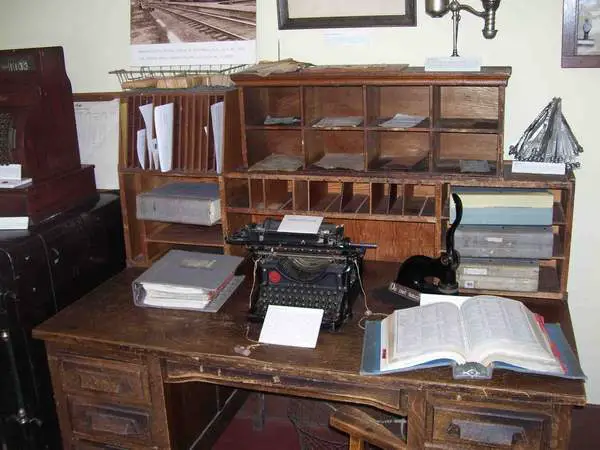 |
A CP Rail station office of the late 1900's |
| This picture was were submitted by Corey Walker, Prince George, BC | |
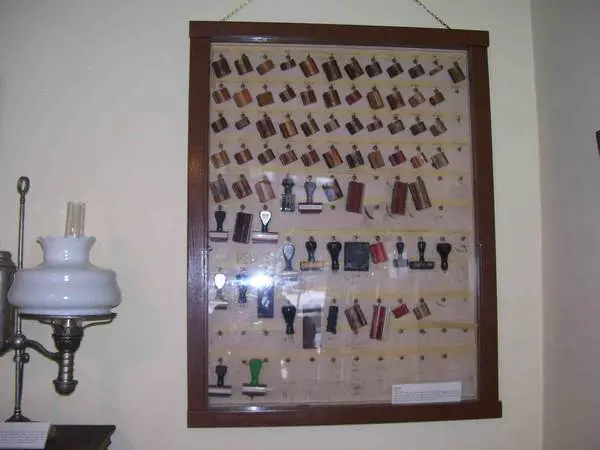 |
Rubber stamps shown with an antique Aladdin's lamp |
| This picture was were submitted by Corey Walker, Prince George, BC | |
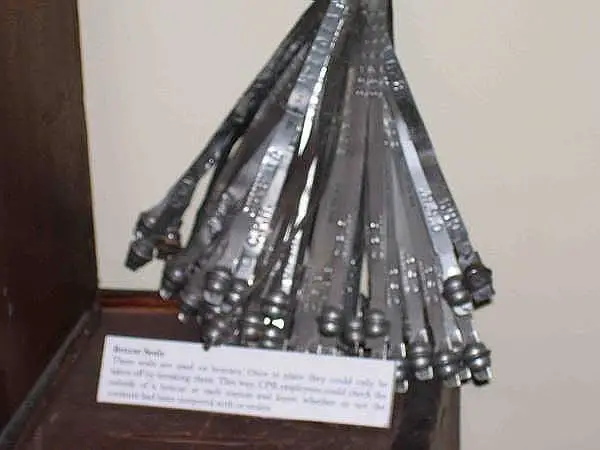 |
Rail car seals |
| This picture was were submitted by Corey Walker, Prince George, BC | |
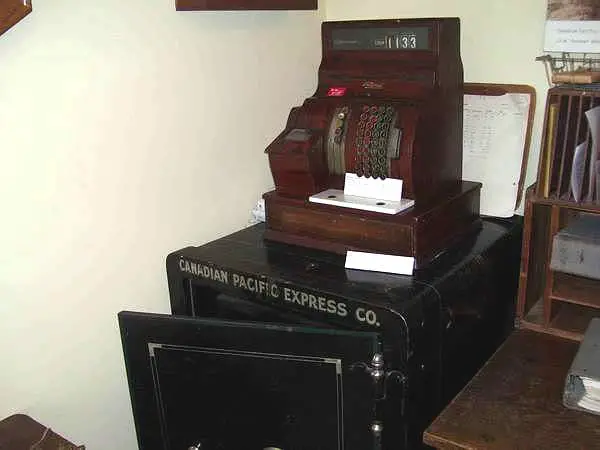 |
A cash register and safe |
| This picture was were submitted by Corey Walker, Prince George, BC | |
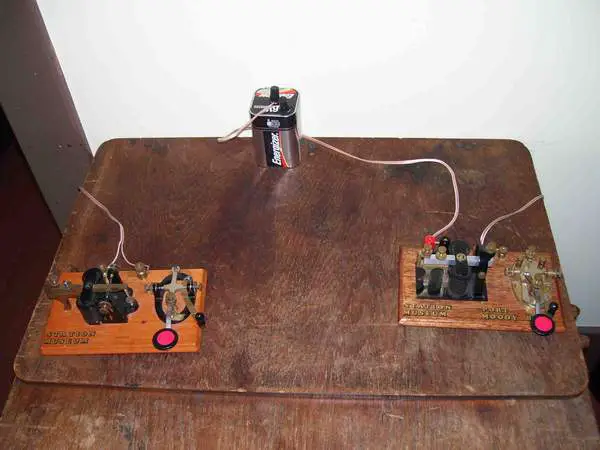 |
CP rail telegraph key demostration |
| This picture was were submitted by Corey Walker, Prince George, BC | |
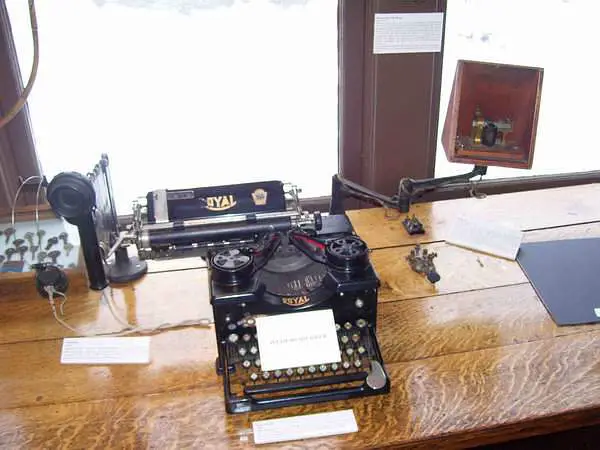 |
A Royal typewriter used by the Station Master |
| This picture was were submitted by Corey Walker, Prince George, BC | |
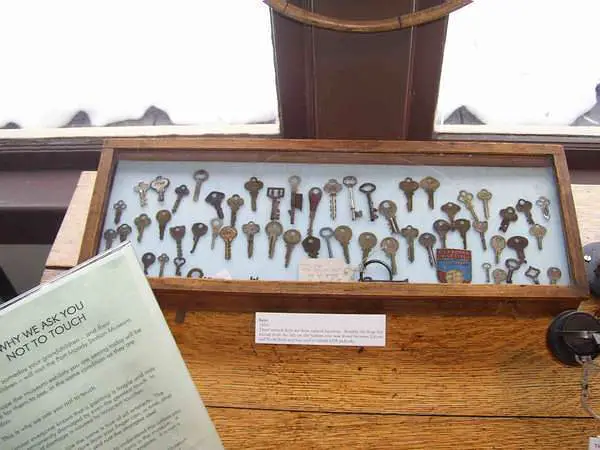 |
CP Rail Keys from various locations
|
| This picture was were submitted by Corey Walker, Prince George, BC | |
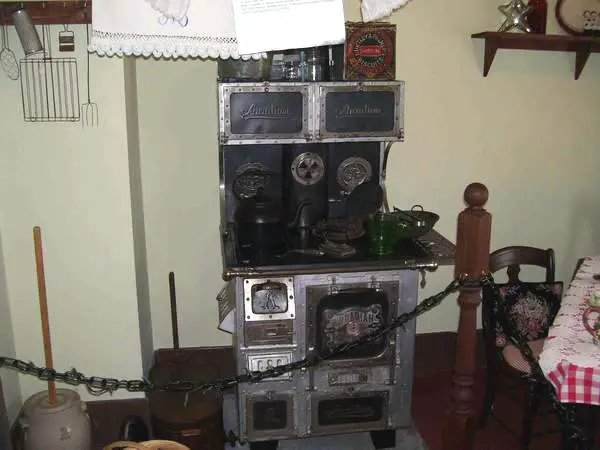 |
Bunkhouse cook stove |
| This picture was were submitted by Corey Walker, Prince George, BC | |
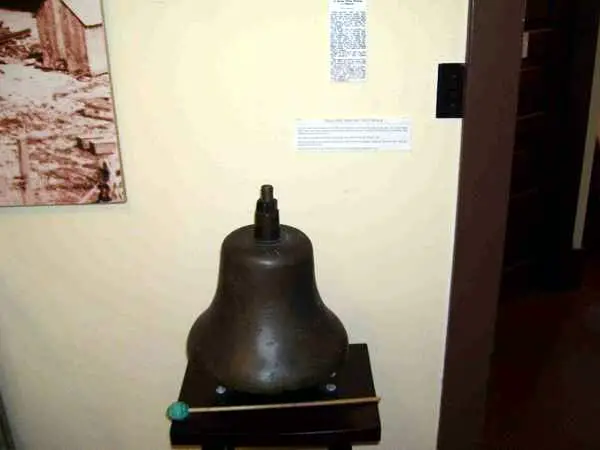 |
Locomotive bell |
| This picture was were submitted by Corey Walker, Prince George, BC | |
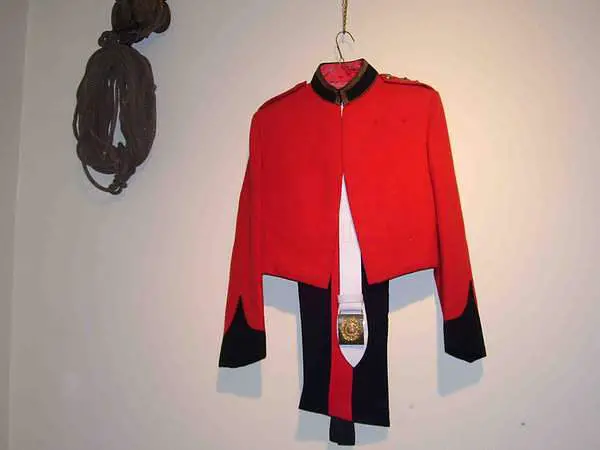 |
Uniform |
| This picture was were submitted by Corey Walker, Prince George, BC | |
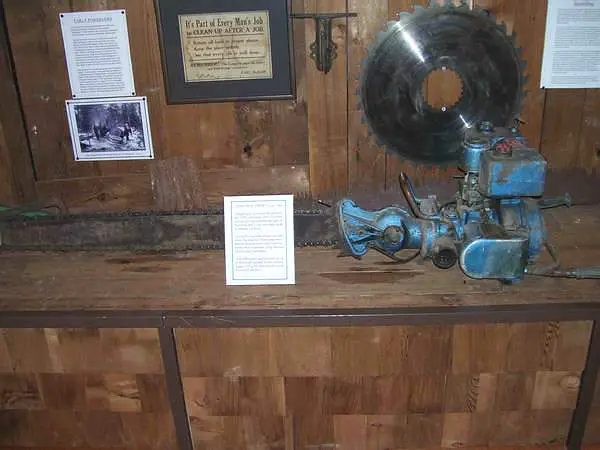 |
Titan "Blue streak"Chain saw used in build the rail lines
|
| This picture was were submitted by Corey Walker, Prince George, BC | |
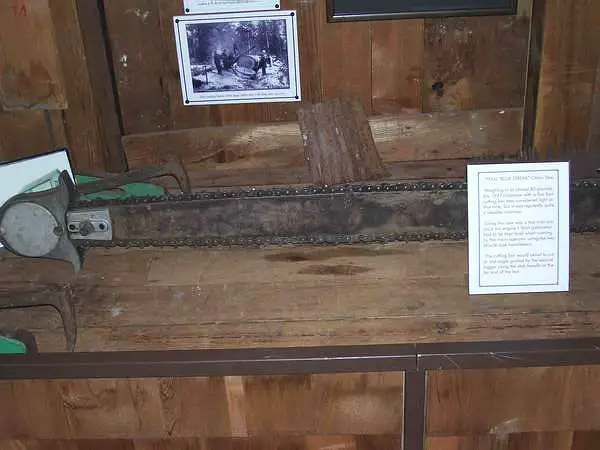 |
Titan "Blue streak"Chain saw used in build the rail lines
|
| This picture was were submitted by Corey Walker, Prince George, BC | |
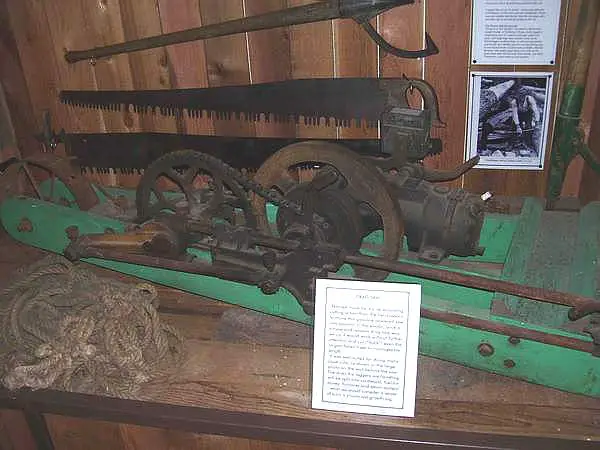 |
Drag saw
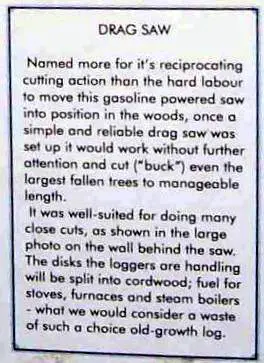 |
| This picture was were submitted by Corey Walker, Prince George, BC | |
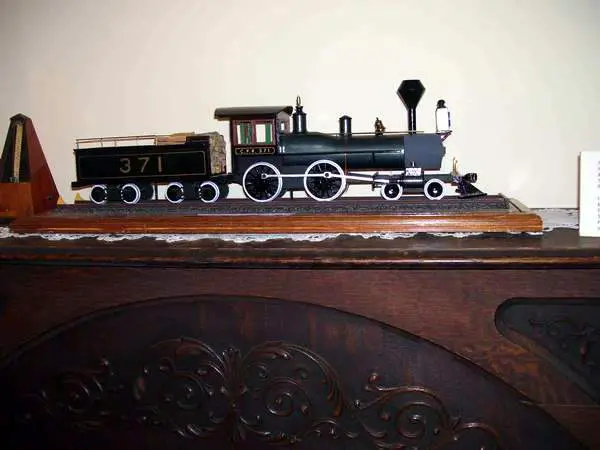 |
|
| This picture was were submitted by Corey Walker, Prince George, BC | |
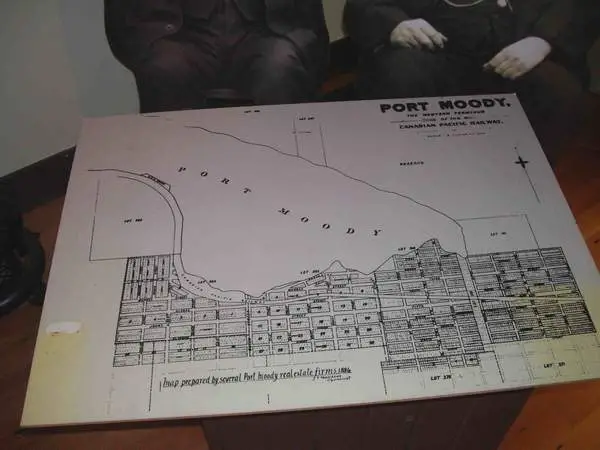 |
Port Moody town plan 1884 |
| This picture was were submitted by Corey Walker, Prince George, BC | |
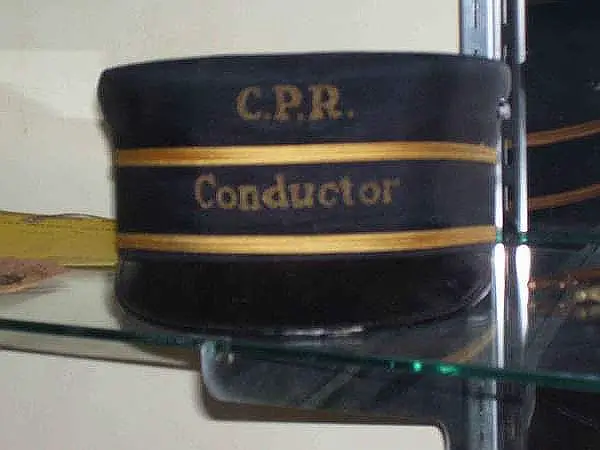 |
Conductor's cap |
| This picture was were submitted by Corey Walker, Prince George, BC | |
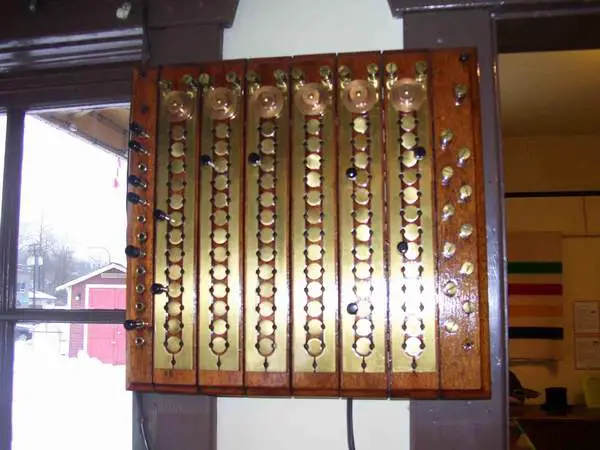 |
|
| This picture was were submitted by Corey Walker, Prince George, BC | |
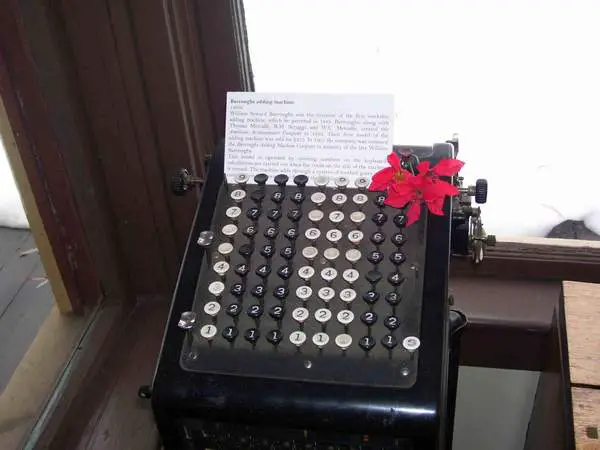 |
Burroughs Adding machine
|
| This picture was were submitted by Corey Walker, Prince George, BC |
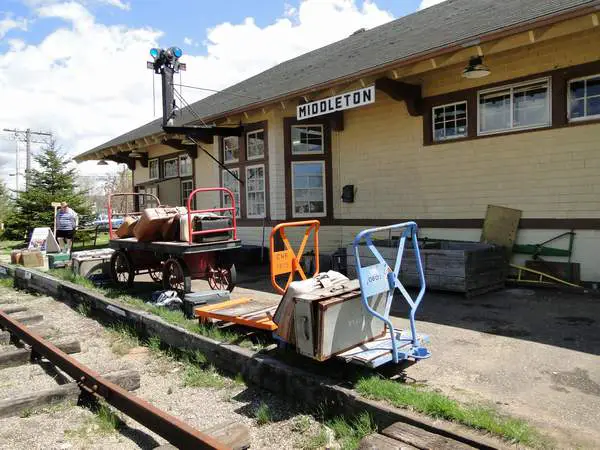 |
Hand Carts shown at the DAR Station, Middleton
Nova Scotia |
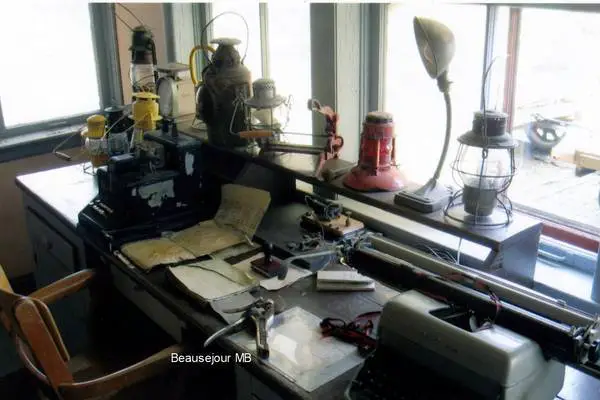 |
Canadian Pacific station at Beausejour MB |
| This picture was submitted by Arthur Grieve, Winnipeg, Manitoba | |
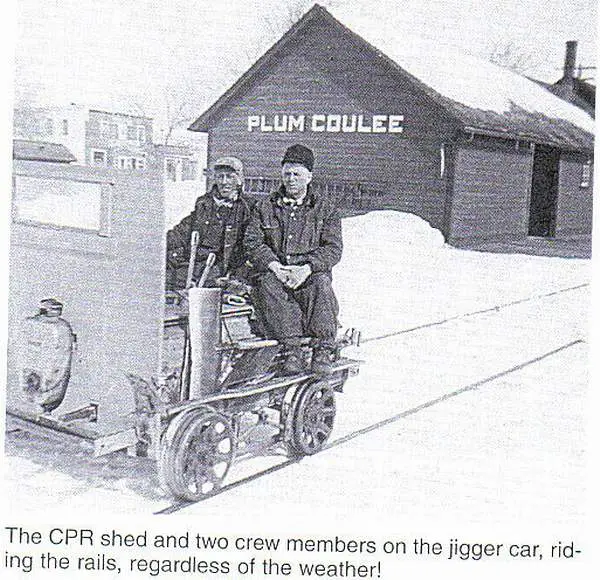 |
CPR Shed and Jigger car |
| This pictures was submitter by Jim Sheppard, Fort Frances, Ontario | |
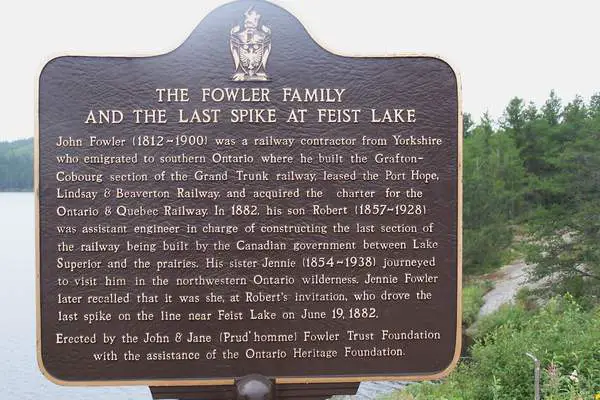 |
Commemorative plaque honoring Mr Fowler, a railway contractor who built part of the CPR line connecting Winnipeg MB and Thunder Bay ON.Work on this line was done from Winnipeg eastward and from Thunder Bay westward. |
| This picture was submitted by Art Grieve, Winnipeg, Manitoba | |
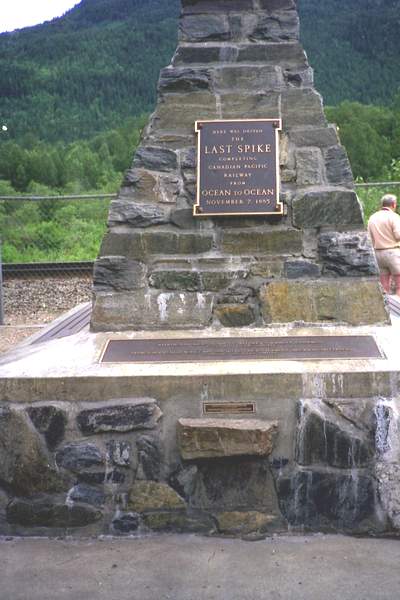 |
Craiglachie BC This is the site where the last spike was driven by Donald Smith, also known as Lord Strathcona on Nov 7, 1885 to complete the Canadian Pacific Rwy. |
| This picture was submitted by Art Grieve, Winnipeg, Manitoba | |
|
|
A "not for sale" poster, picked up, while visiting Prince
George BC in 1975. advertising a visit by the BC Museum
Train, composed of some logging artifacts and railcars full of exhibit material. View a picture of the Museum Train at http://www.flickr.com/photos/37908073@N04/4634612806/ On August 2, 1975 (following the visit advertised on the poster
and proceeding further north), ex-CPR Consolidation
|
| This picture was submitted by Massey F. Jones | |
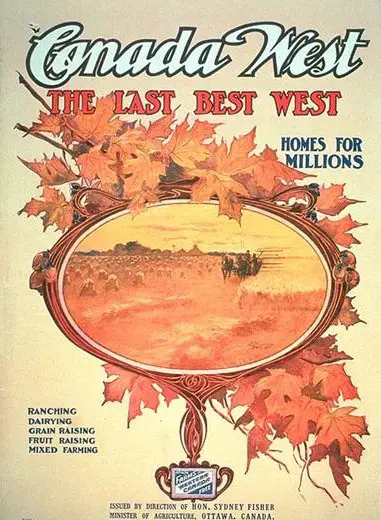 |
|
| This picture was submitted by Art Harris | |
|
|
Interior of the CNR Station, Sussex, New Brunswick |
| Rob Hayes, North Williamston, Nova Scotia | |
|
|
Interior of the CNR Station, Sussex, New Brunswick |
| Rob Hayes, North Williamston, Nova Scotia | |
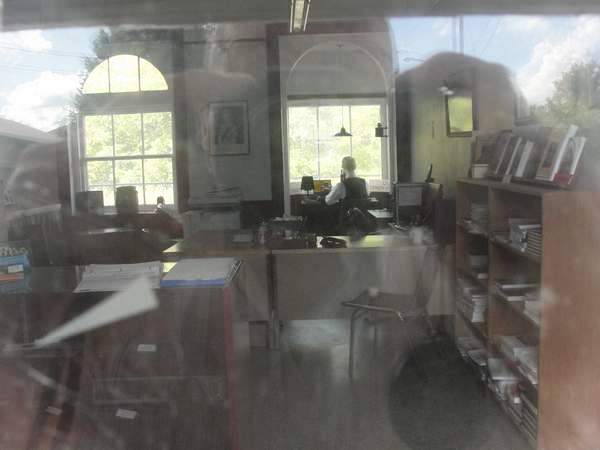 |
CNR Station Prescott ON with a dummy operator for the benefit of tourists |
| This Picture was submitted by Jean Guy Hamel and were taken by a
friend on a recent trip to the area. |
|
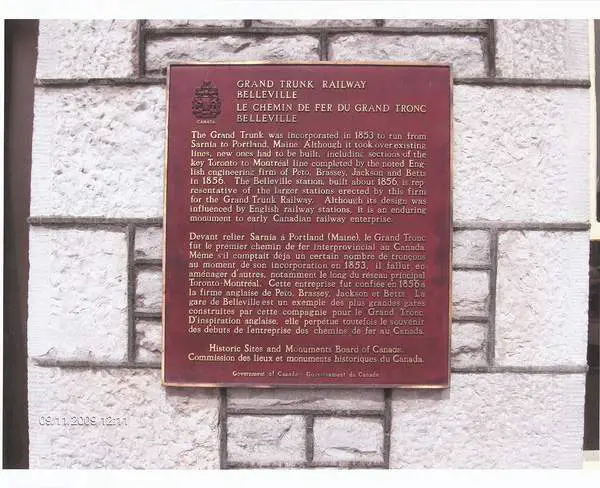 |
Bellville Grand Trunk Station (Now a VIA Station) |
| This picture was submitted by Bruce Polmanter, Bellville ON. | |
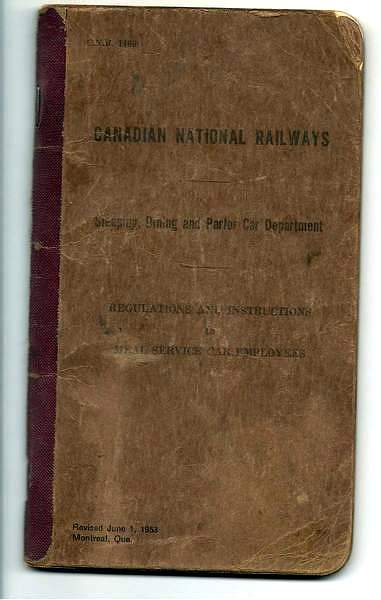 |
CNR regulations and instructions to meal service car employees Sept
1 1928. This was revised June 1 1953.
This was owned by Billy's father Mickey Huey who was chef of the dinning car for over 30 years from Halifax to Montreal |
| This picture was submitted by Bill Huey Stewiacke N.S. | |
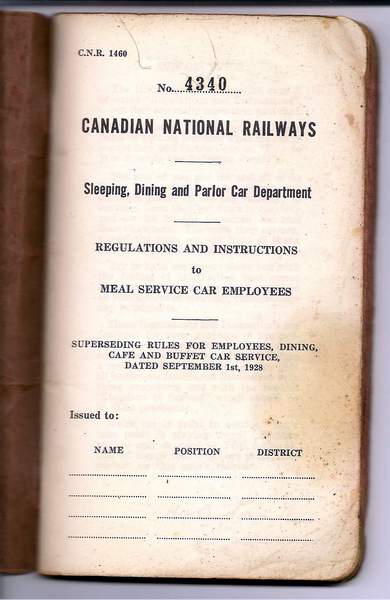 |
CNR regulations and instructions to meal service car employees Sept 1 1928 |
| This picture was submitted by Bill Huey Stewiacke N.S. | |
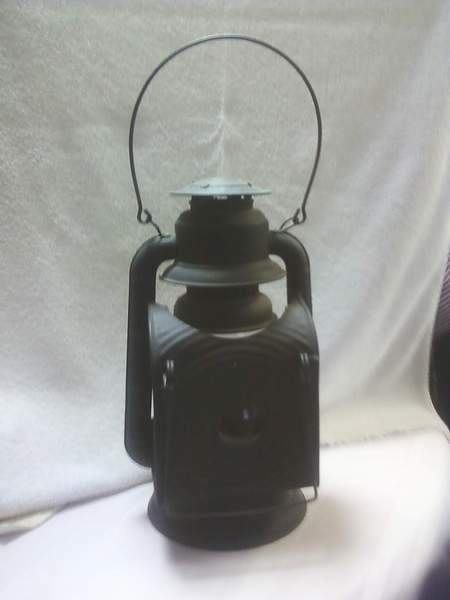 |
CNR lantern. Billy is not sure what it was used for. The
front has a red light that lights up when the lantern is lit. It may hung at the tail end of the train maybe on the caboose. If anyone knows what this lantern was used for please let us know. |
| This picture was submitted by Bill Huey Stewiacke N.S. | |
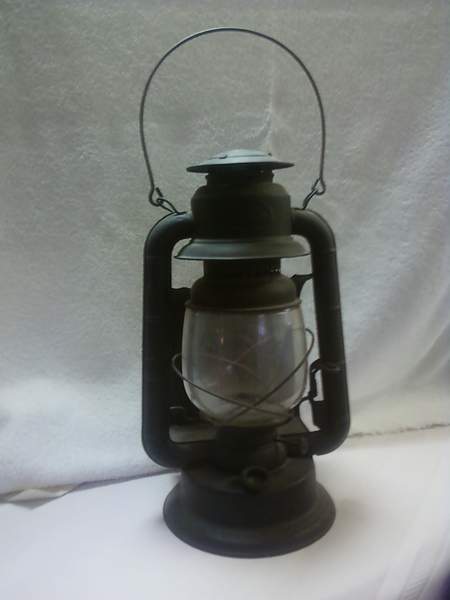 |
CNR lantern |
| This picture was submitted by Bill Huey Stewiacke N.S. | |
 |
Canadian RY switch keys |
| This picture was taken and submitted by Jim Booth, Willingdon AB | |
 |
Canadian RY switch keys |
| This picture was taken and submitted by Jim Booth, Willingdon AB | |
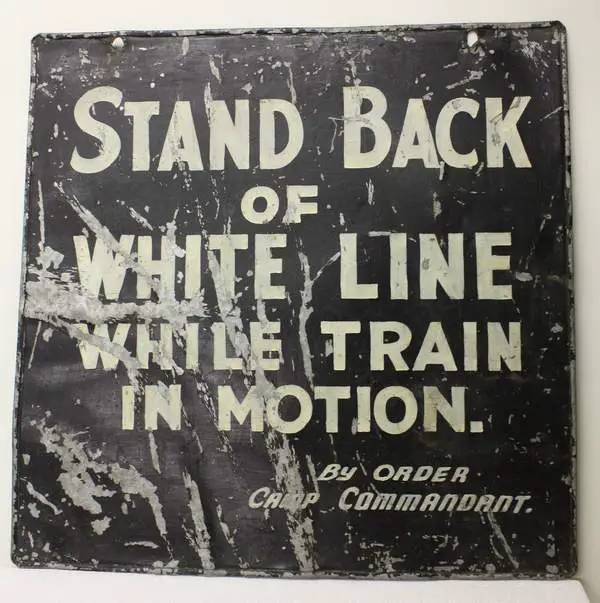 |
The black sign was attached to the CN Station
at Camp Shilo during WW2 |
| This picture was taken and submitted by Jim Booth, Willingdon AB | |
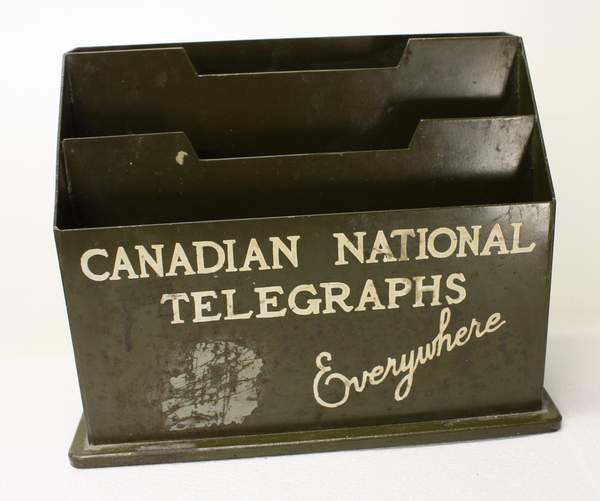 |
CN Telegraph Stand |
| This picture was taken and submitted by Jim Booth, Willingdon AB | |
_wood_conductors_case.jpg) |
This wood conductors case belonged to the late
Mr. Glen Wales an LE&N conductor. |
| This picture was taken and submitted by Jim Booth, Willingdon AB | |
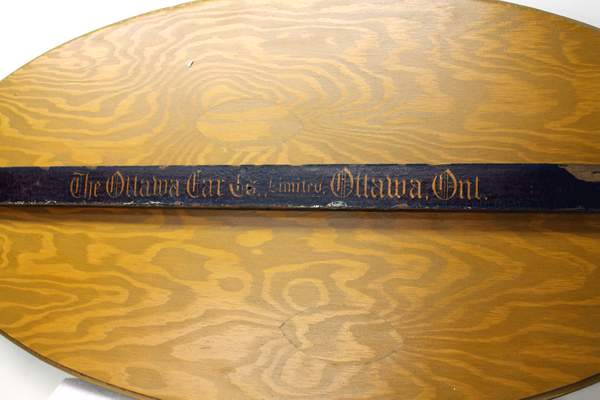 |
This Ottawa Car Co. sign was given to by a CP employee
in Moose Jaw Sask. He picked it up at the dump when the streetcars were being destroyed. If I get a chance the sign will be donated to the museum in Moose Jaw. |
| This picture was taken and submitted by Jim Booth, Willingdon AB | |
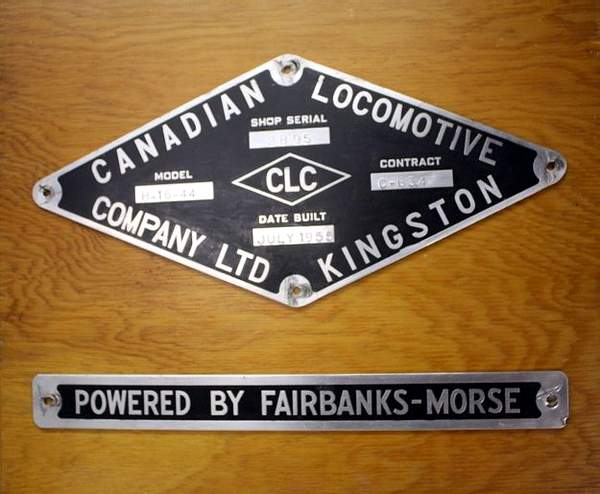 |
CLC Builders Plate Engine 8552, 1958 |
| This picture was taken and submitted by Jim Booth, Willingdon AB | |
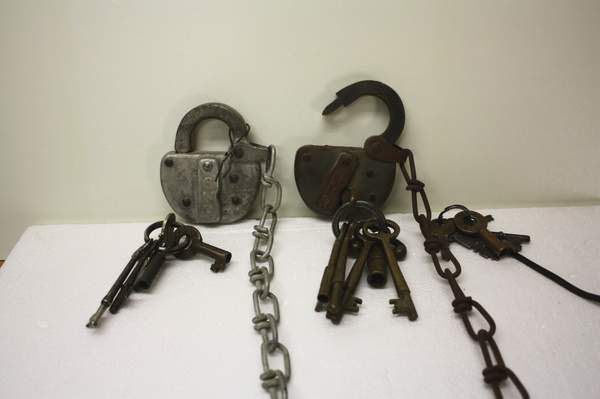 |
CN and CP Switch Locks and Keys |
| This picture was taken and submitted by Jim Booth, Willingdon AB | |
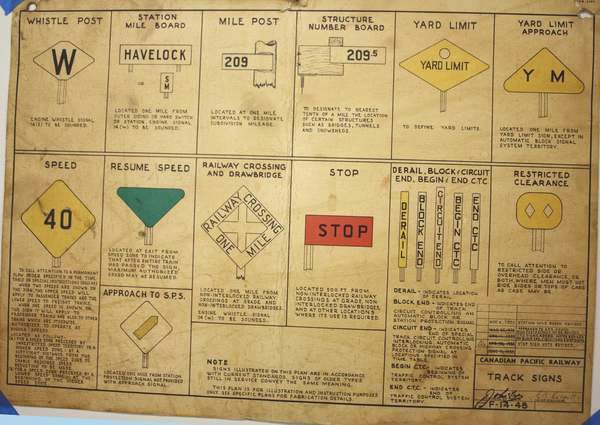
Click on this image for a larger view in a new window |
CP Track Signs from 1955 |
| This picture was taken and submitted by Jim Booth, Willingdon AB |
A collection of CPR Stoves to be found at Larry Buchan's
operates a railway museum
in the High River area south of Calgary.
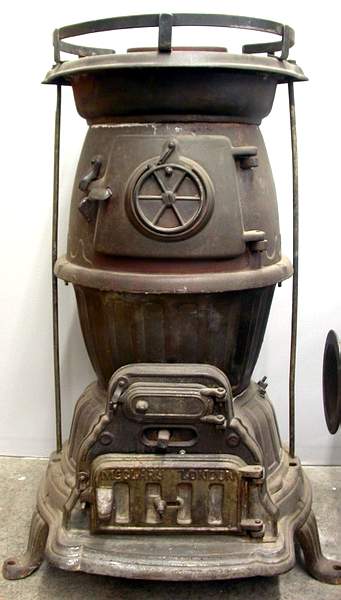 |
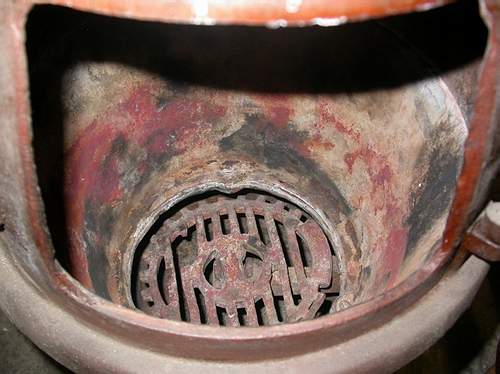 |
|
|
|
 |
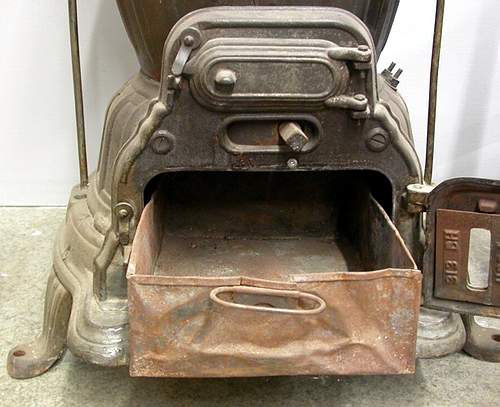 |
|
|
|
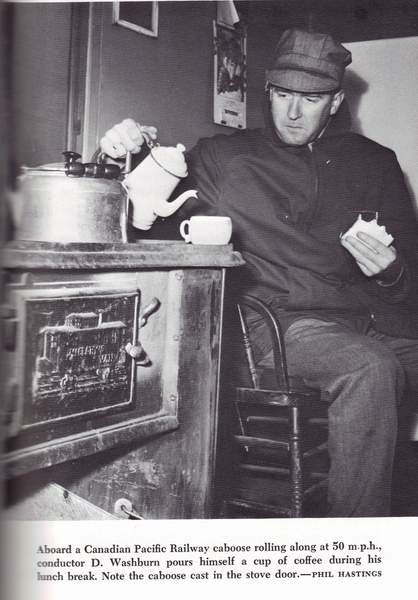 |
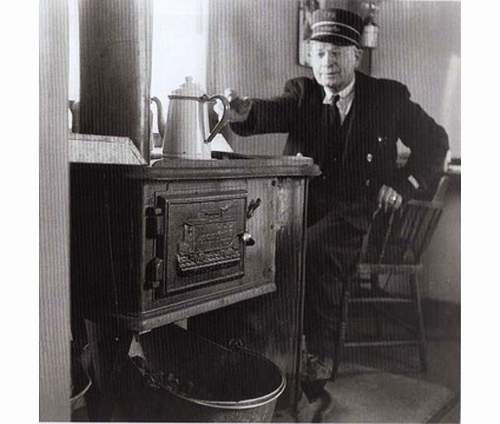 |
|
that could be used for baking, and as an extra hotplate on top to cook with. |
|
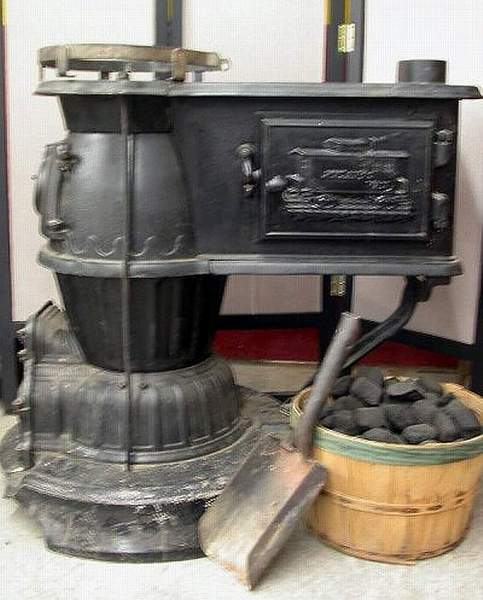 |
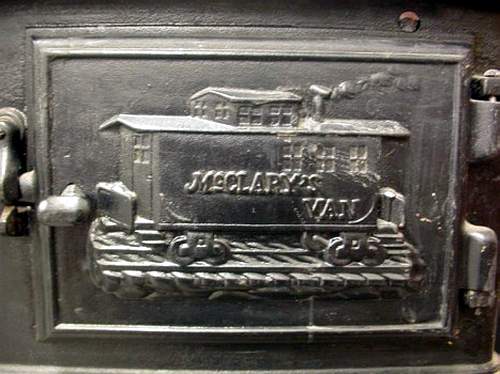 |
|
|
oven doors with a view of a caboose. |
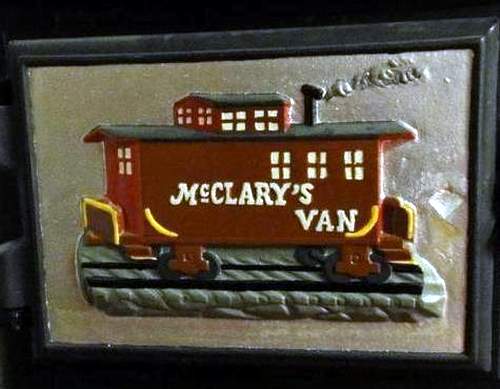 |
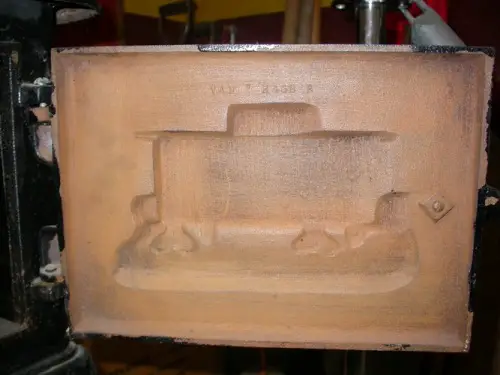 |
|
|
|
 |
| This is the fuel pot of a CPR switch or caboose marker
kerosene lantern the front door of the lantern would slide upwards and
the pot wouldslide out, By pulling on the steel wire loop that is soldered
onto thetop of the pot, where the wick adjuster sits underneath protruding
outside the lantern when the front door is closed. This was t facilitate
refueling the lantern and other repairs like changing the wick can be done,
and the four wire loops around the wick mechanism held a small Pyrex glass
mantle the pot held enough fuel to last 30 hours I believe.and the wick
portion would unscrew for it to be filled with kerosene, I have attached
some photos from my collection of caboose markers, and switch lanterns.
I got my caregiver to take two photos this afternoon of the insides of
my caboose marker lanterns, the first one is the lamp on the right-hand
side, it shows how the front light panel slides up, and you can see the
fuel pot that is decorative as this marker has been converted to electricity
with a clear Christmas light inside, the last picture Shows
the insides of my other caboose marker lanterns on the right-hand side, this one is fully equipped with the Pyrex chimney that I told you about, they helped from keeping drafts blowing out the wick in stormy weather, and that the wire handle for controlling the Length of the wick goes tothe right of the door, unlike the example you showed me that goes underneath the wire Handle for pulling it out. Larry Buchan |
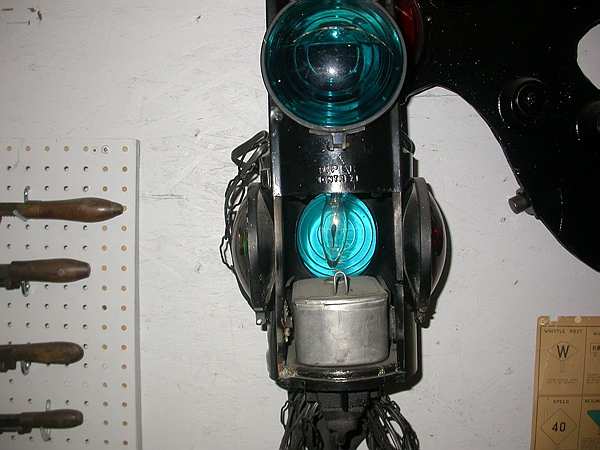 |
CPR caboose marker front opened |
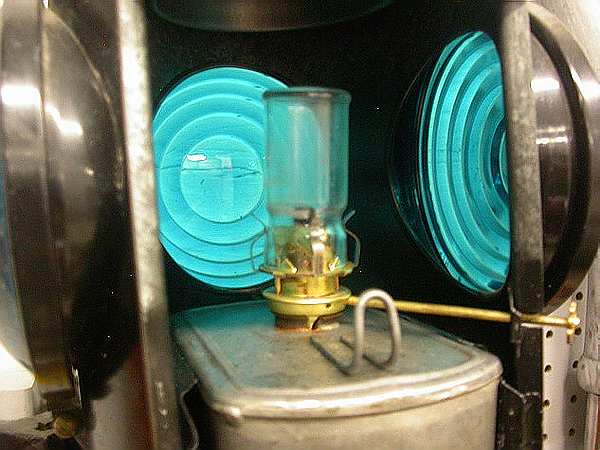 |
CPR caboose marker lamp Pyrex glass chimney |
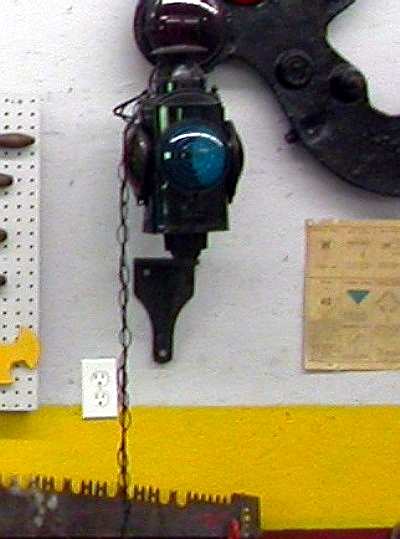 |
CPR kerosene switch lantern |
| Larry Buchan operates a railway museum in the High
River area south of Calgary. Larry was an engineer for the CPR. The following
pictures were taken at his museum, Later this summer he
will be sending me closeups of many of the artifacts shown in the group pictures |
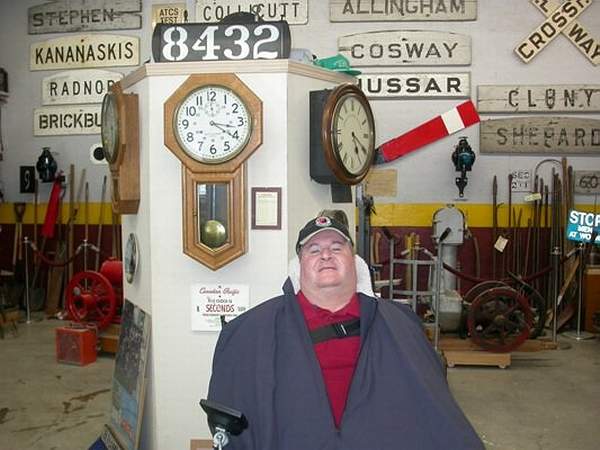 |
|
|
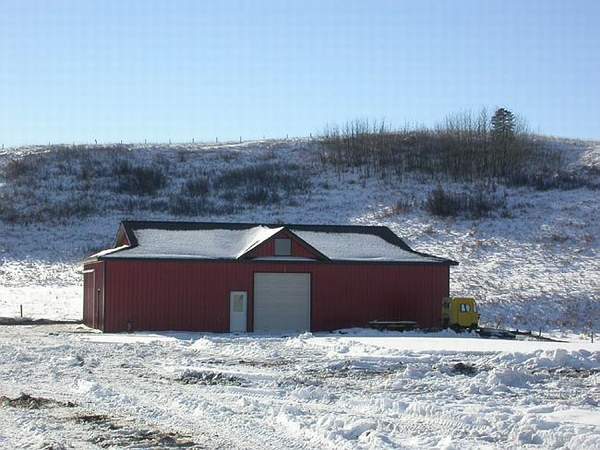 |
|
|
We have been having some interest lately in lamps and
lanterns used by the railways.
Larry sent me the following pictures of his
CPR Desk lamp.
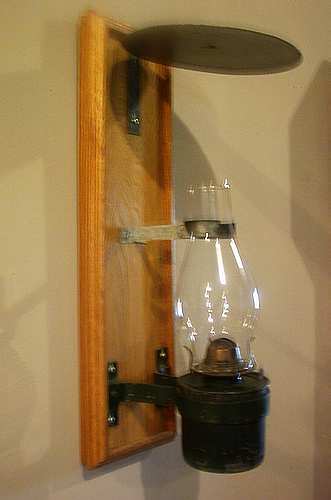 |
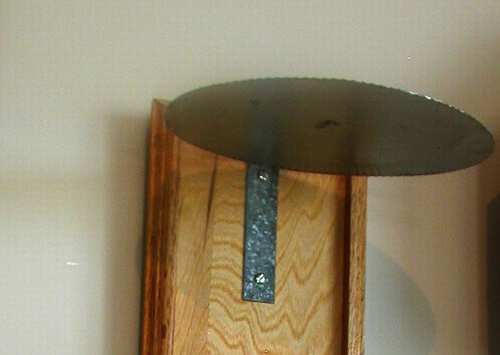 |
|
|
above the lantern to catch all the soot from the lamp. |
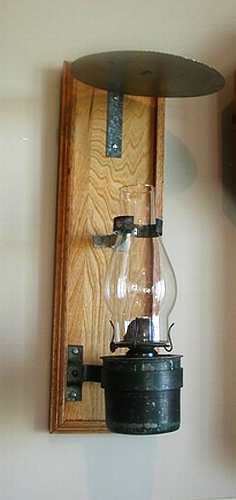 |
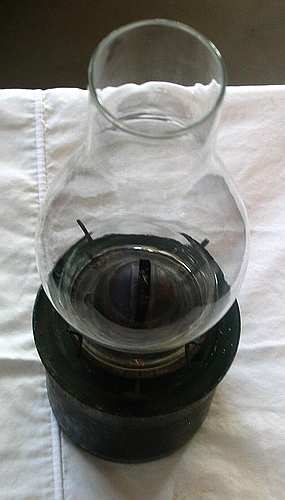 |
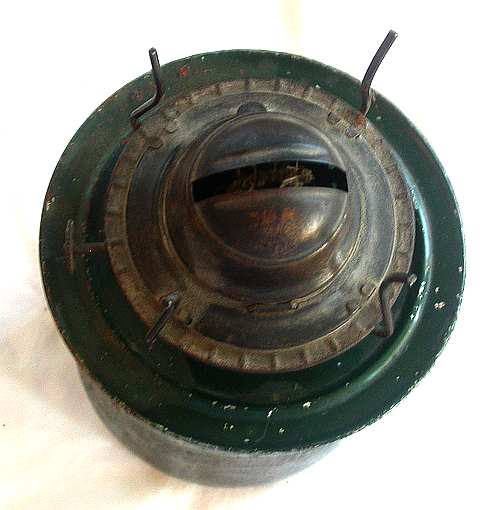 |
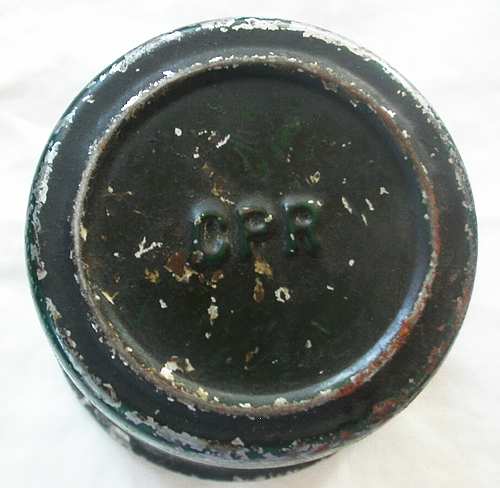 |
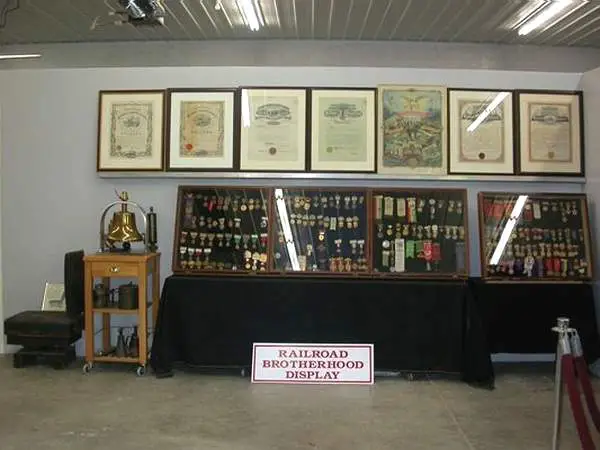 |
An engineer seat 1890, Budd car Bell, Brotherhood
charters convention medals |
 |
CPR. ITR punch clock from roundhouse. CPR engineer
tags and assignment board. |
 |
Brotherhood of Locomotive Engineers, Brotherhood of Locomotive Firemen,
Brotherhood of Railroad Trainmen, Order of Railway Conductors Ribbons,
railway shaving
mugs, railway hats, conductor punches, railway pocket watches, railway switch keys and locks, other artifacts including brake club, and handbrake wheels. |
 |
Brotherhood of Locomotive Engineers, Brotherhood of Locomotive Firemen,
Brotherhood of Railroad Trainmen, Order of Railway Conductors Ribbons,
railway shaving
mugs, railway hats, conductor punches, railway pocket watches, railway switch keys and locks, other artifacts including brake club, and handbrake wheels. |
 |
Station name boards, and mileboards, caboose markers, switch lamps,
train order semaphore signal, sectionmen's Tools, electric switch
lock, cast whistle post, signal block indicator, train order hoop, Fairmont
speeder engines,
CPR CNR meat hooks, machinists wrenches, derail & sign, stepping stools, |
 |
Station name boards, and mileboards, caboose markers, switch lamps,
train order semaphore signal, sectionmen's Tools, electric switch
lock, cast whistle post, signal block indicator, train order hoop, Fairmont
speeder engines,
CPR CNR meat hooks, machinists wrenches, derail & sign, stepping stools, |
 |
CPR ticket cabinet, and safe, telegraphic equipment, my workshop in the background. |
 |
CPR and CNR railway clocks, watchmakers cast-iron store sign, steam locomotive builder plate NYC steam locomotive, CPR coach mirror, Mars headlight, steam locomotive headlight From tender, Seth Thomas locomotive cab clock. |
 |
CPR and CNR railway clocks, watchmakers cast-iron store sign, steam locomotive builder plate NYC steam locomotive, CPR coach mirror, Mars headlight, steam locomotive headlight From tender, Seth Thomas locomotive cab clock. |
 |
CPR and CNR railway clocks, watchmakers cast-iron store sign, steam locomotive builder plate NYC steam locomotive, CPR coach mirror, Mars headlight, steam locomotive headlight From tender, Seth Thomas locomotive cab clock. |
 |
CPR diesel number board 8432,
CPR Seth Thomas World clock |
 |
CNR switch stand, CPR caboose stove, CPR 12 Street interlocking tower sign, CPR oil cans. |
 |
My Library, Seth Thomas No. 17 Regulator from
Fort William station and lots of other artifacts. |
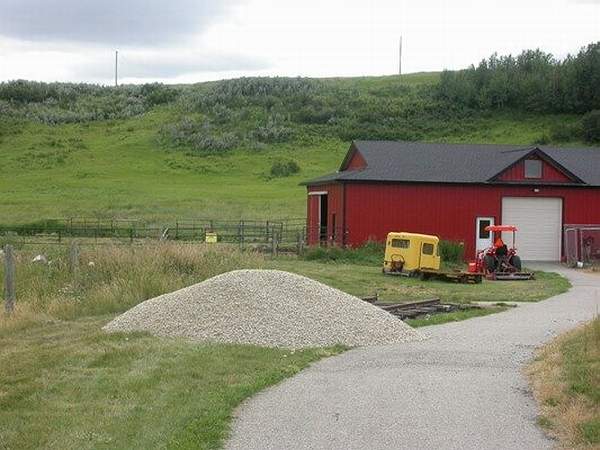 |
CPR track relocation project summer 2011, our tractor, speeder, pushcart, track, ballast. finished project with ballast spread, and derail mounted, and locked. |
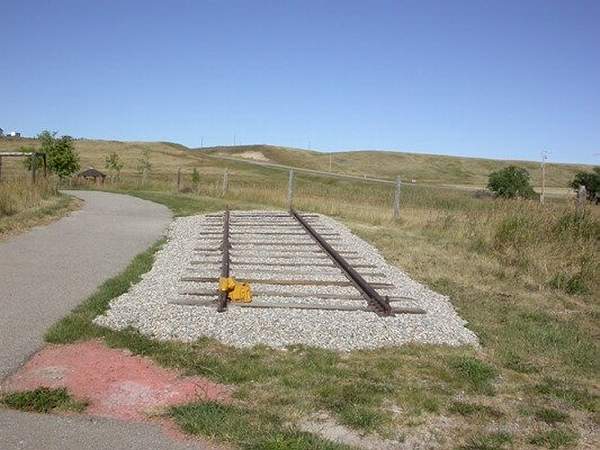 |
The finished project |
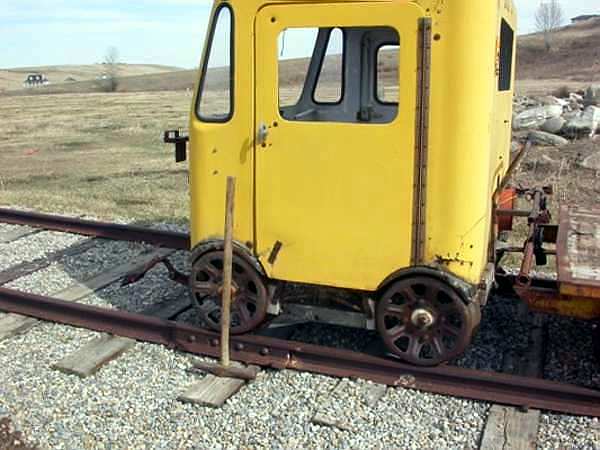 |
Larry Buchan submitted this series of CPR section men tools.
This pictures shows a CPR spike maul beside his speeder |
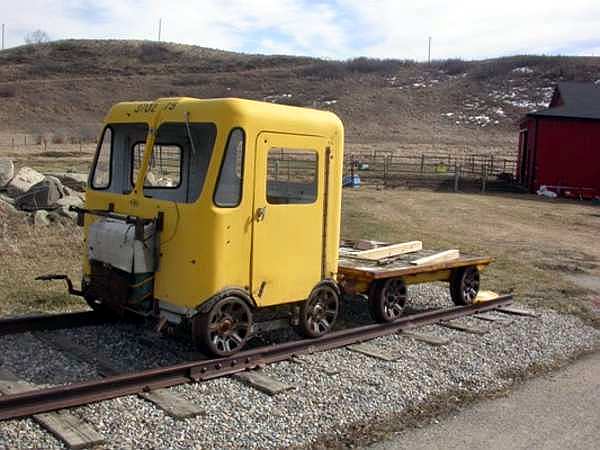 |
The speeder and puchcart |
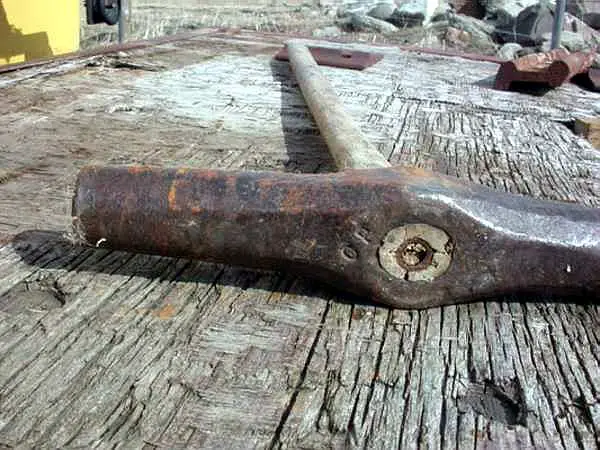 |
|
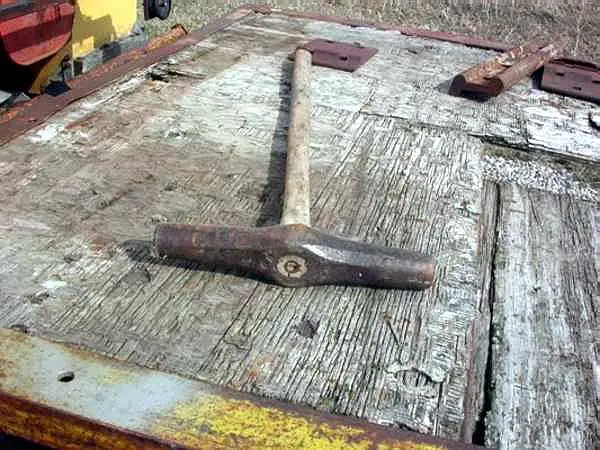 |
|
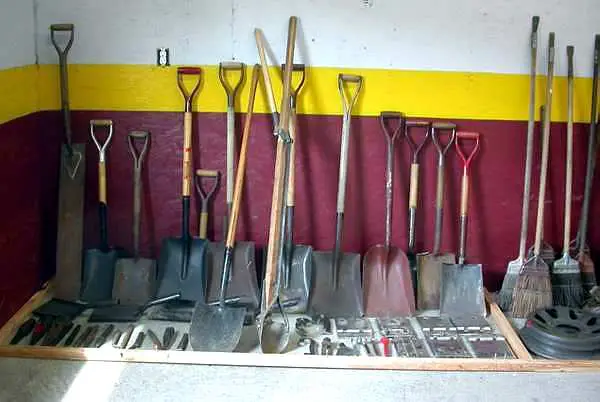 |
CPR shovels, note the one on the left it is used for
shoveling between the railway ties, in the middle is one for digging post holes. In the winter time, every track switch would have a shovel and a broom for the train crews to be able to shovel and sweep the snow out of the track switch so they could operate it. |
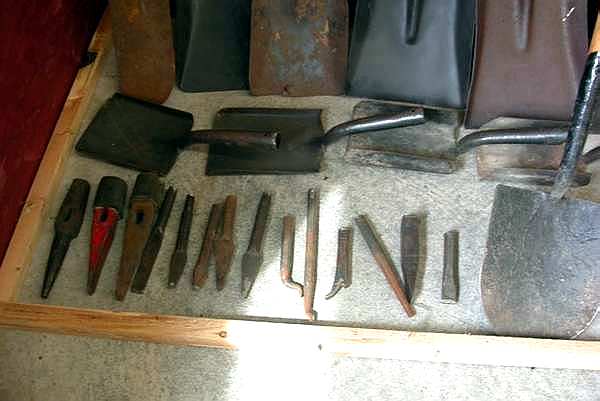 |
Some CPR small shovels for coal stoves, along with
some chisel hammerheads, and special chisels for different purposes. |
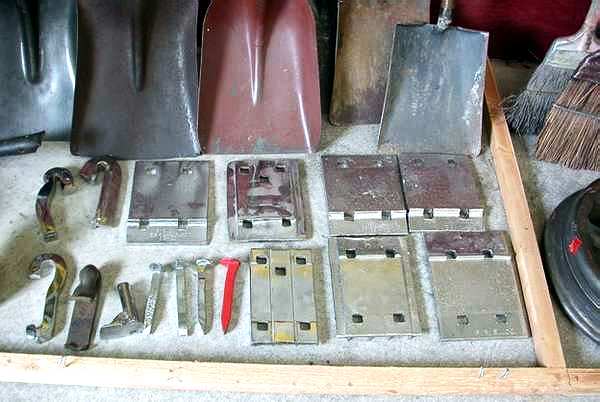 |
CPR rail clips that were used to stop the track from
getting out of line. They were clipped underneath the rail, and against the wooden tie. Railway spikes, and railway tie plates a lot of these track materials were nickel plated probably for retirement presents, they would usually be like the ones you could see on my speeder pushcart. On the right-hand side in front of the broom you can see a speeder wheel. This is no ordinary one, as you can see a bead of 1/4 steel has been welded around the metal of the tread, these wheels would be used in the winter time like we use snow tires, they would break the ice on the rails for traction. |
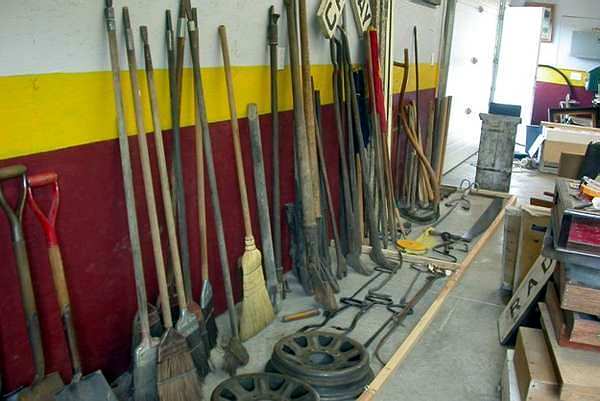 |
Behind the speeder wheels are CPR switch brooms
made of nylon bristles to last longer, and the ends have a ice pick. Very handy for chipping out ice of track switches. Beside the brooms are track jacks used to move boxcars by leverage, they are placed under the wheels and have a mechanism that has serrated teeth that digs into the rail and when placed against a boxcar wheels the car will start moving with the handbrake released, and can be stop by using same, or by putting it piece of wood under the wheel if the gradient is not too severe, these were used by elevator agents who had to move up to a dozen cars for loading in their elevators, sectionmen would also use them to move cars of materials. |
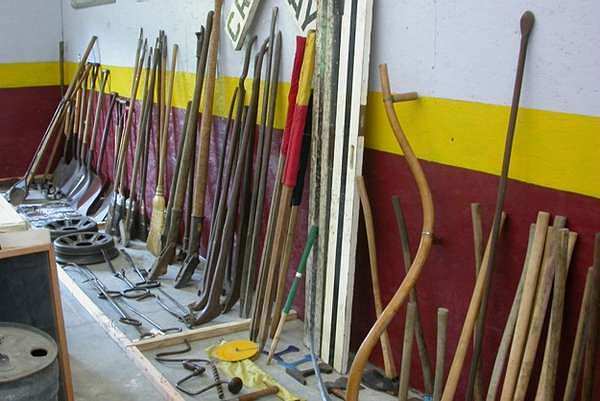 |
Another view showing in the foreground the handle of a
grass scythe, some elevation boards with levels to check the track elevation, yellow and red flags, and red flags to set up at work limits to warn train crews to stop before reaching the point of where the track was being repaired. Next are some CPR track crowbars, some have a claw at there foot to be able to pull out track spikes, and some are just straight and used as lining bars to move track and ties |
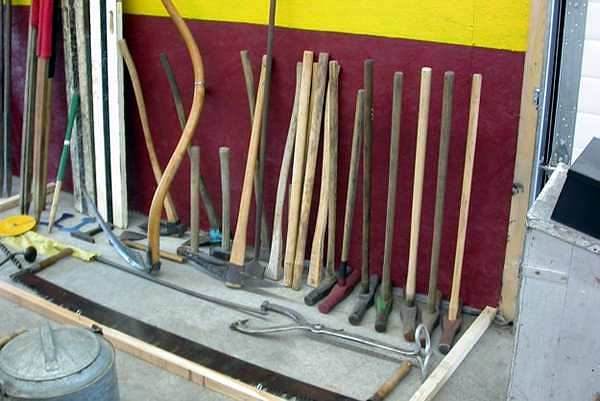 |
Last photo showing my spike mauls, the one in green is
Great Northern, In the foreground a set of tongs for moving track ties, and a two man buck saw, besides the spike mauls are handles for replacing broken one's, a pick, and some adzes used to notch out track ties for tie plates, you can see them leaning behind the scythe handle. |
| When I am at home, I do give tours. We have a watch and clock collectors
club in Calgary that I started as a charter member 30 years ago, and we
hold the annual barbecue out here. I also had a group of senior citizens
from the local extended care in the High River Hospital out here, they
came by a large handy bus, many were in wheelchairs so we have a luncheon
and gave them the tour, which worked quite well as our house, deck around
three sides, and paved roadways to the barn make it very handicapped
accessible. Last summer we did some work with some help from a friend of
mine who works as a CPR conductor, when I had my accident some coworkers
and management from the
CPR send of the crew of sectionmen and set up for me 40 feet of track, It is 65 pound rail from the 1880s, and ties, with a speeder and pushcart. The rail is really old and everything was sitting in the weeds beside my barn as you can see in the picture. So with his help and our tractor we disassembled everything, moved he ties, and rails reassembled everything, and brought in a truckload of ballast. We have some work to do on the speeder, and pushcart to set it up as a static display. And later I will add some of my track signs, signals, I even have a set of crossing lights. |
| The following display was submitted by Larry Buchan,
High River Alberta
It shows a number of railway locks, keys and other track control devices. They are part of the disappearing railway heritage of both the CPR and CNR The the CPR uses these type of locks for their switches, derails, trackside phones, register stations, bill boxes and and any other appliance that train crews needed to do their day-to-day work. The Maintenance of Way (section men.) Had their own special locks for their tool houses, and supply cars, and coaches they used. These type of switch locks were used from About the 1930s right up till today, on the mainline, and other locations were safety is concerned new high-security steel switch locks started to be used in the 1990s, these locks were equipped with steel keys, that could not be removed from the lock unless it was in the closed position. The older locks were equipped with brass keys, these and their locks have become quite collectible from the carriers all over North America. Most brakeman carried tool house keys, as they were handy for getting to trackside phones inside section man's tool houses, especially in inclement weather, we also carried coach keys for cabooses, locomotives, and passenger coaches. The older style of locks did their purpose, but could be easily opened, I remember some of the old switchman that never carried a CNR switch key in the CPR yard at Alyth where we used to have to Service customers Spurs like the old BA refinery in Calgary that was accessible from the old Grand Trunk Pacific lead beside our yard, they would just pick up a nice sized boulder and throw it downwards onto the switch lock and after a couple of attempts the lock would soon open, the lock mechanism would be useless, but the switch lock hasp could still be used as a keeper to keep the handle from moving upwards. Larry noted that the newer CPR switches lock were manufactured by the R.M. Co. (Robert Morris Corporation) |
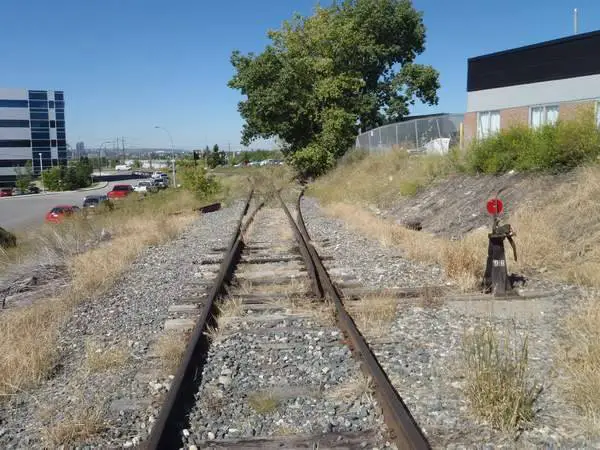 |
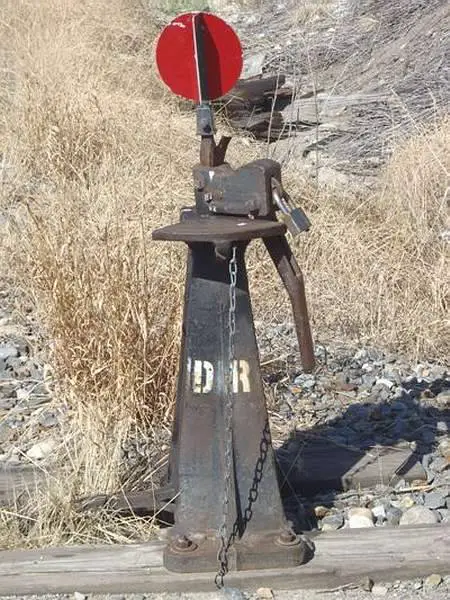 |
|
territory lead in NE Calgary. Note switch is lined for the derailing position as indicated by the red switch target. |
chain from old-style lock hanging downwards off of switch stand table. |
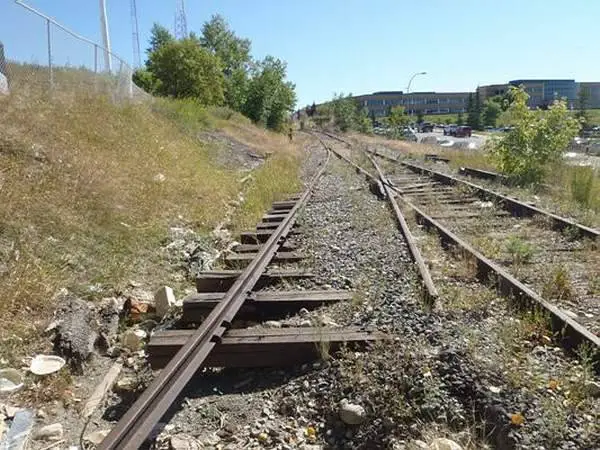 |
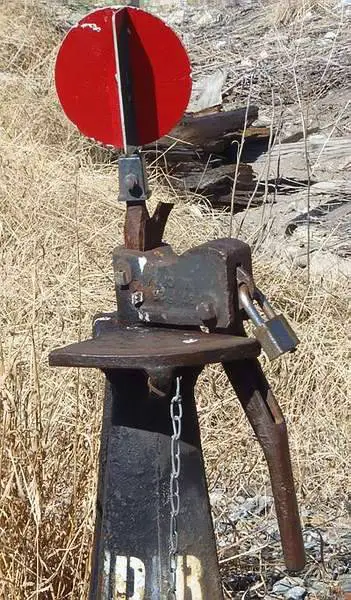 |
|
on this lead above Deerfoot trail below the Calgary Herald building, this territory has become obsolete with the advent of containerization and most of this track has been torn up. |
chain from old-style lock hanging downwards off of switch stand table. Close up |
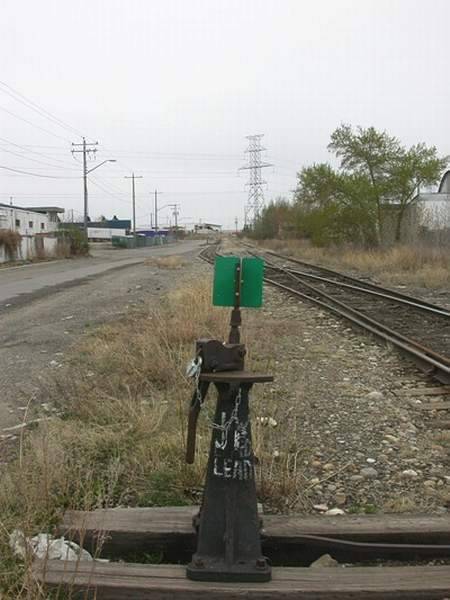 |
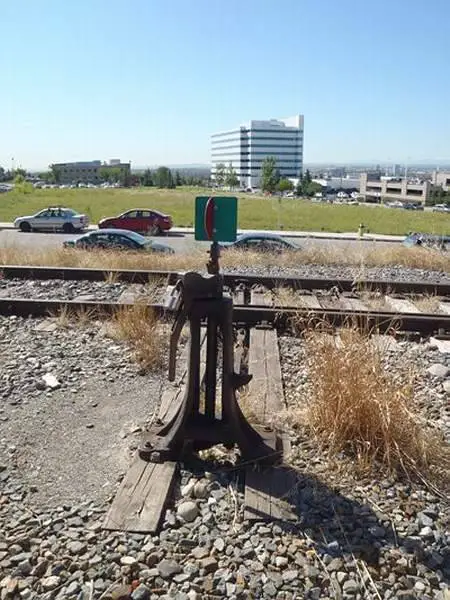 |
|
S.E. Calgary with CPR Lock |
CPR derail switch view from behind, showing green target when
lined for lead,
conventional derails like the one from the JD-4 Canada cement spur do not work on these grades so that is why switch point derails are used. |
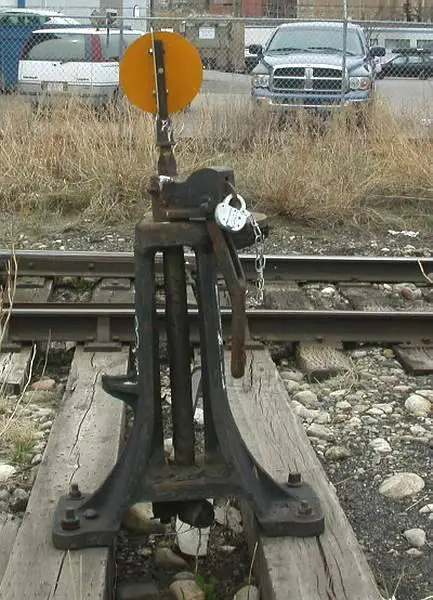 |
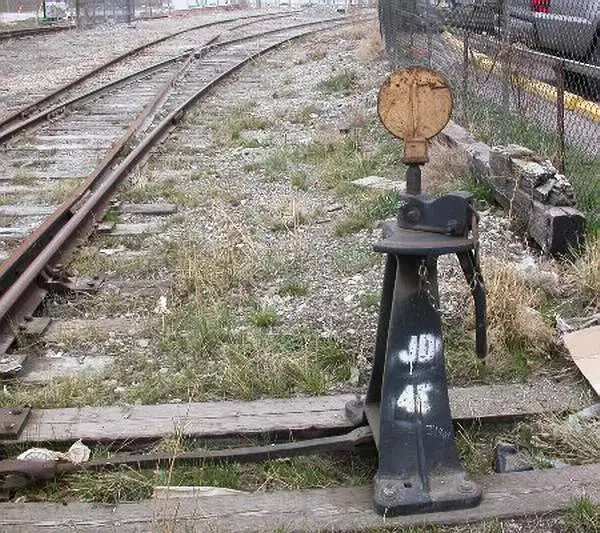 |
|
|
|
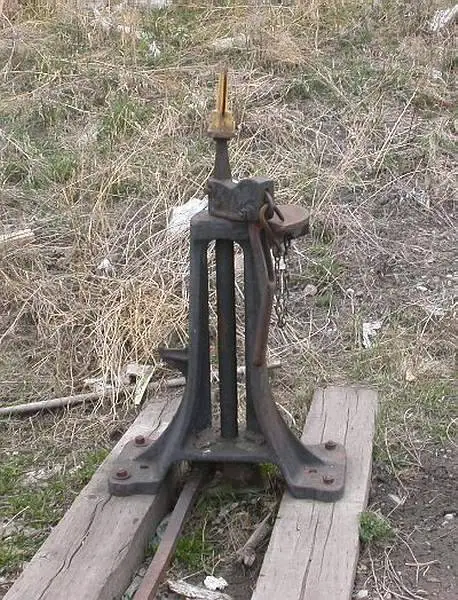 |
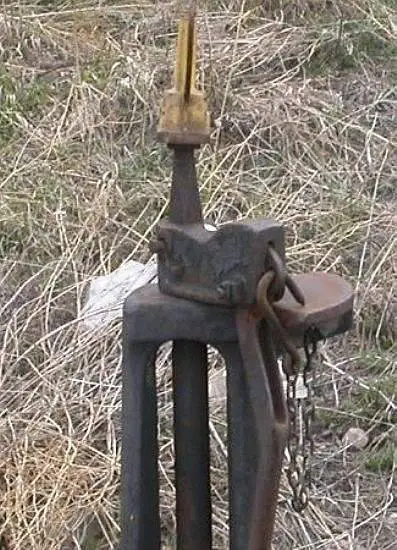 |
|
|
blacksmiths at CPR's Ogden shops from hot rolled steel rod. |
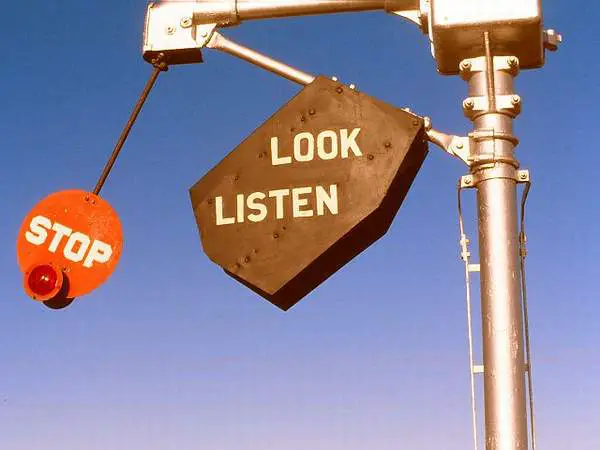 |
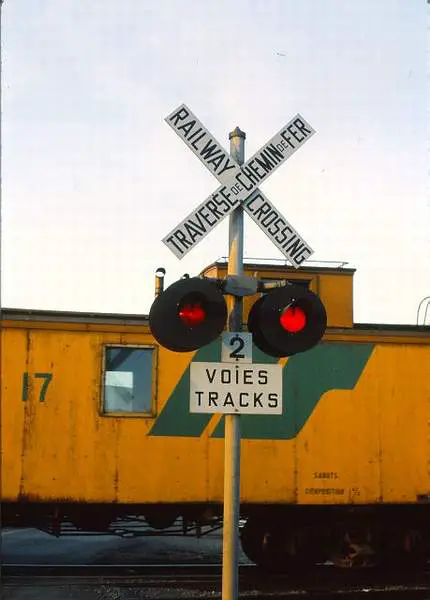 |
| Long before there were LED crossing lights, there was
the wigwag signal.
In small towns, the changeover to crossing lights, was as late as the 1980s. There were several models produced in US and Canada. The US models had a slightly different design. This view shows the model in very wide use, all over Canada by CN and CP. Just like today, as a train approached the road crossing, a spring released the arm and the signal oscillated back and forth under control (hence the name wigwag), while a large bell above rang with a "ding-dong" sound matching the swinging of the arm, to warn motorists and public. After the train had passed, the arm retracted into the cover and locked and the bell silenced until the next train. |
At uncontrolled crossings in Quebec, railway signals
are bilingual. This one is in the Roberval Saguenay Railway yard in La
Baie (formerly Port Alfred) QC. A signal such
as this is commonly called a "crossbuck". It is no different to any in general use at the time, except for the wording. Most of these wooden crossbucks today are highly collectible items. |
| This picture was taken and submitted by Massey F. Jones | This picture was taken and submitted by Massey F. Jones |
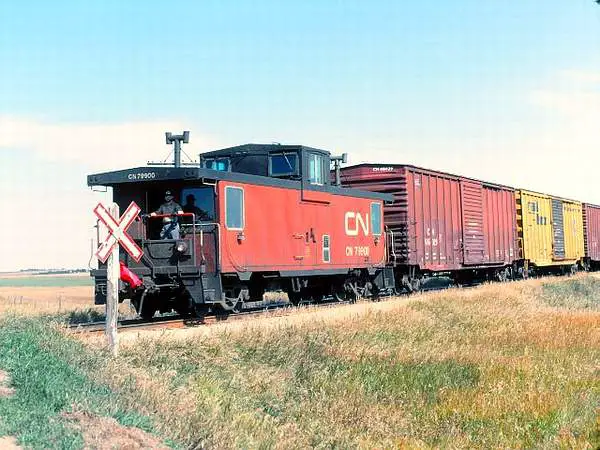 |
|
| This is fairly the standard aluminum crossbuck found today in Canada,
especially
along crossings between farmers fields. This one is in Alberta on the Three Hills Sub, north of Calgary, just screwed to a crude post which probably had a wooden version for years. |
|
| This picture was taken and submitted by Massey F. Jones | |
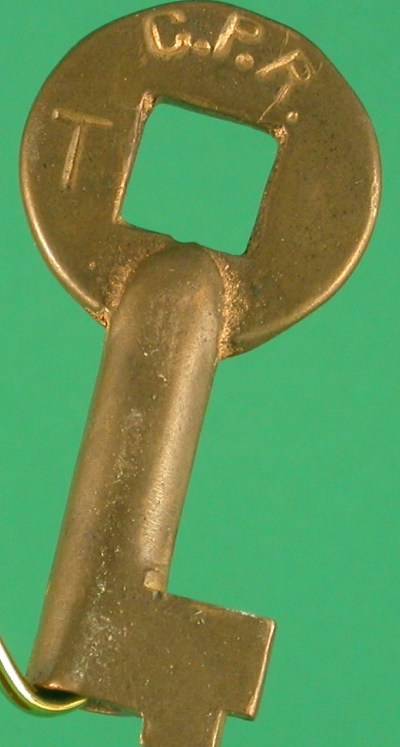 |
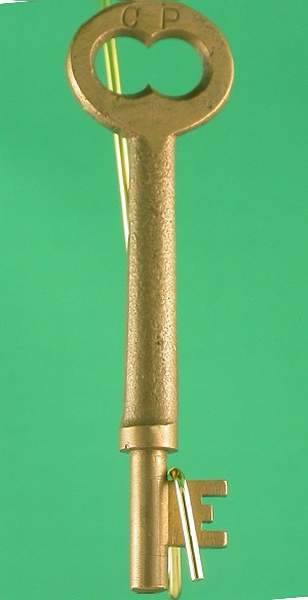 |
|
note square hole made them easy to identify on key ring |
|
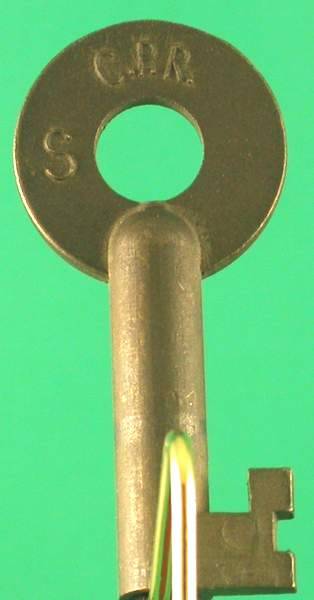 |
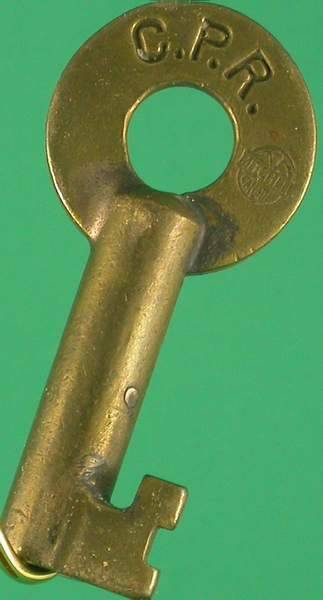 |
|
|
stools and other hardware for the CPR |
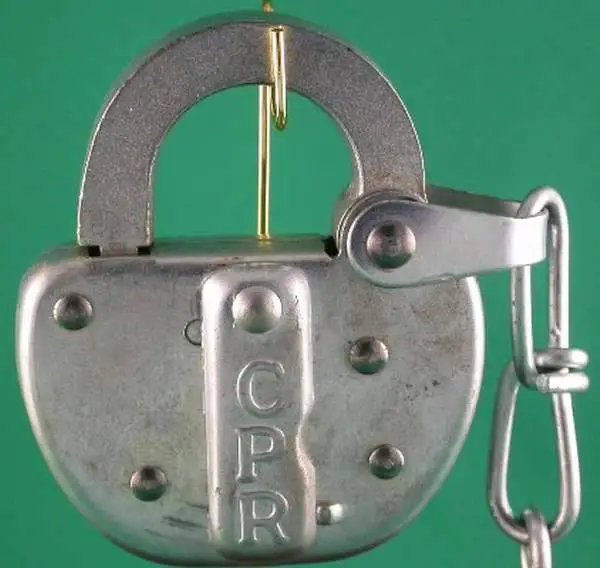 |
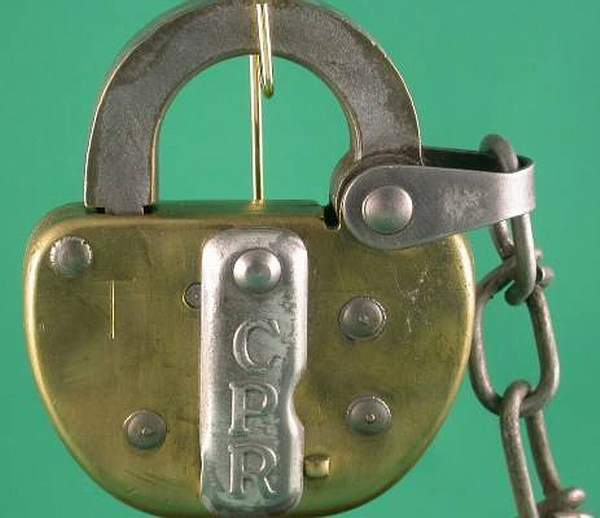 |
|
|
|
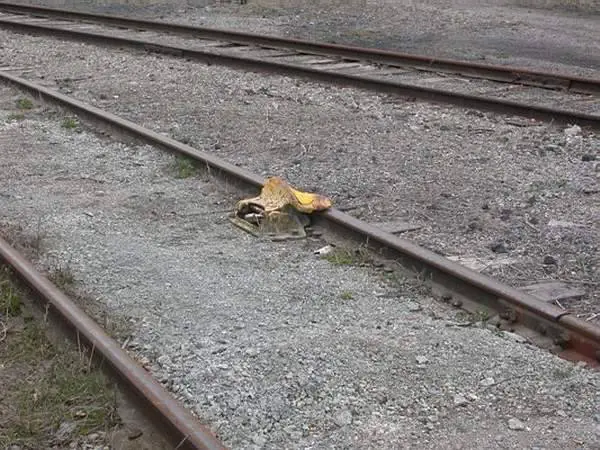 |
|
|
Manchester industrial district Calgary |
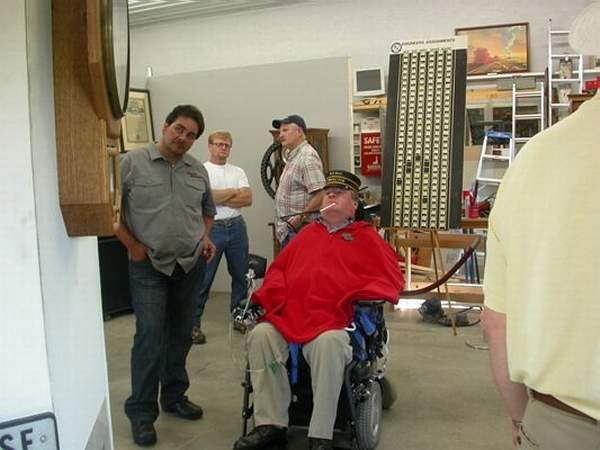 |
Annual Watch and Clock Collectors barbecue Museum
tour August, 2011 |
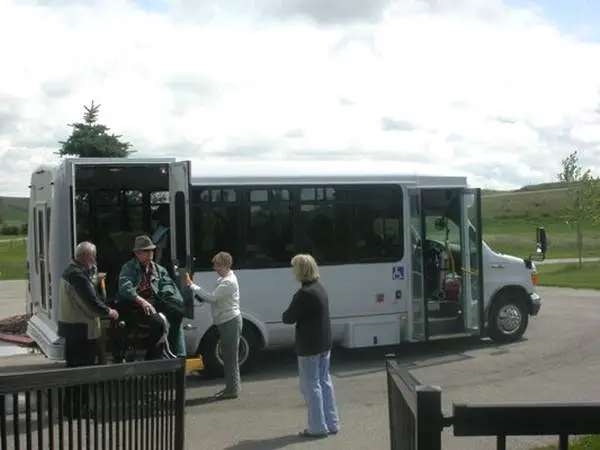 |
High River Seniors visit on July 19, 2010, my wife Anita welcoming the visitors. |
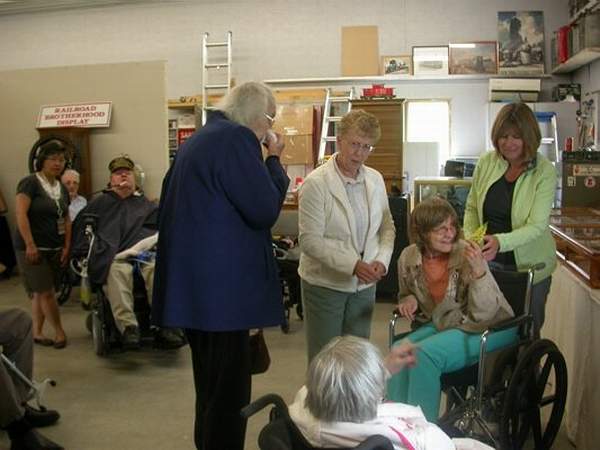 |
Museum tour. This was his first opening and they still
hadn't finished painting the walls, and putting in the doors. |
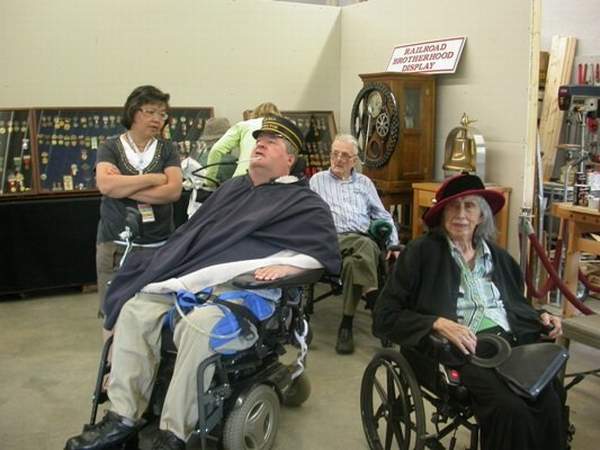 |
|
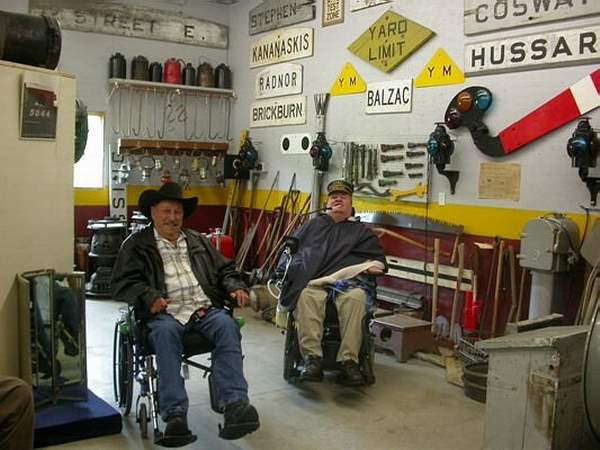 |
|
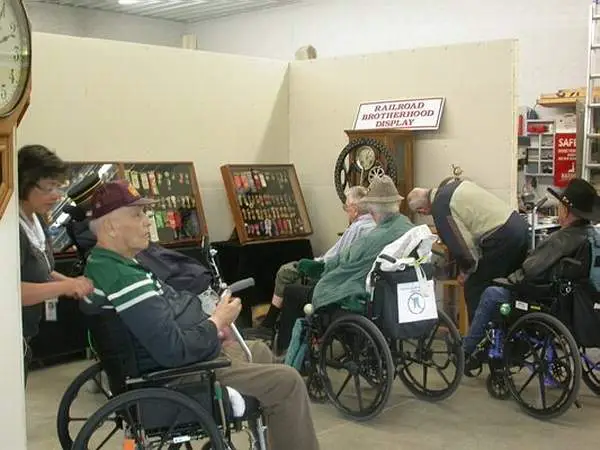 |
|
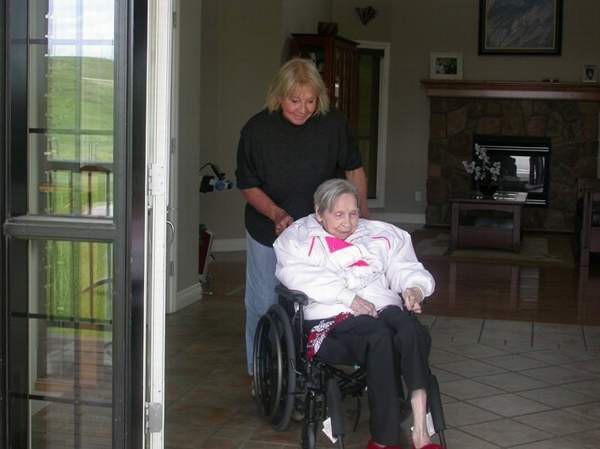 |
Larry's wife Anita escorts her mother Hilma out to the
handy bus. |
|
|
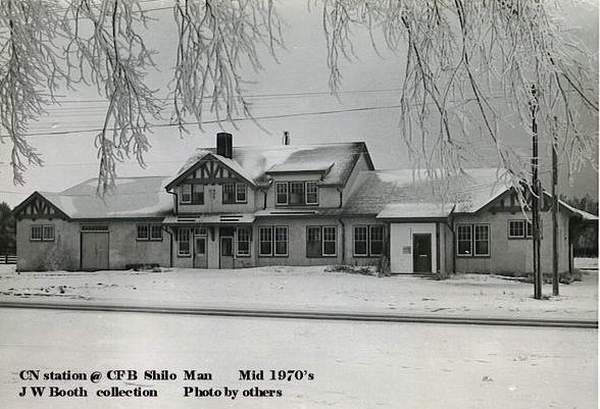 |
CN Station, Shilo. Man. Mid 1970's |
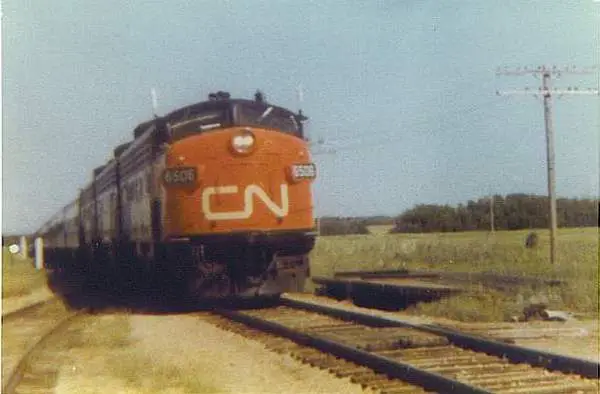 |
CN 6506 leading the Royal Train at Shilo Man. 1970 |
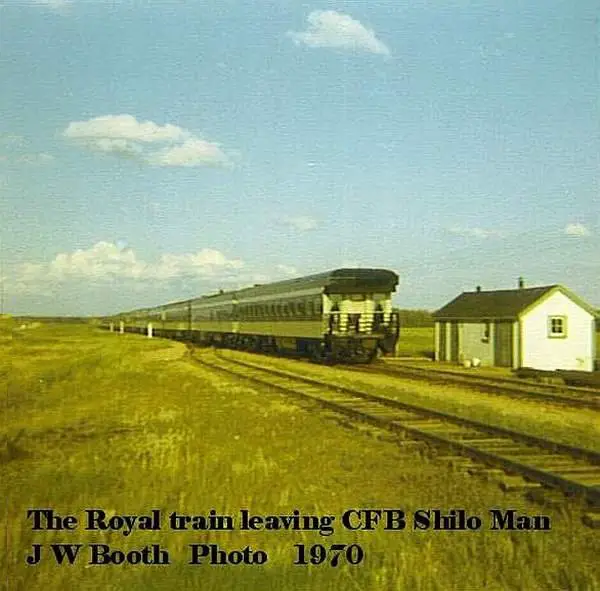 |
The Royal Train leaving Shilo Man. 1970 |
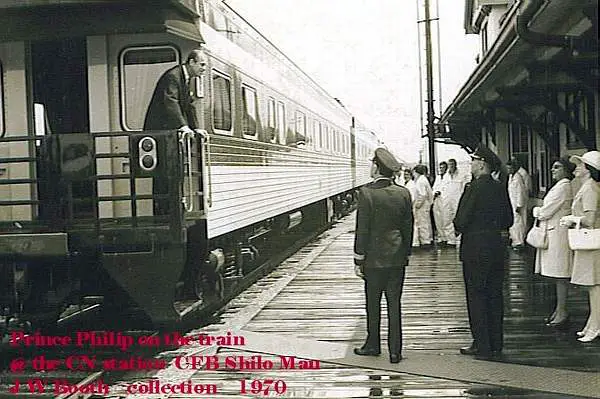 |
Royal Train with Prince Philip at
CN Station Shilo MB 1970 |
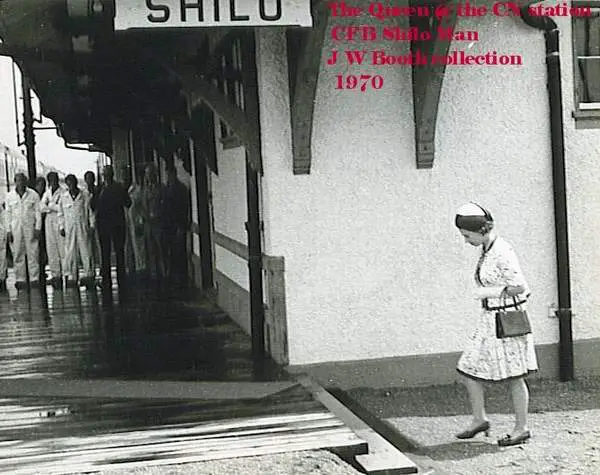 |
Queen Elizabeth at Shilo MB. 1970 |
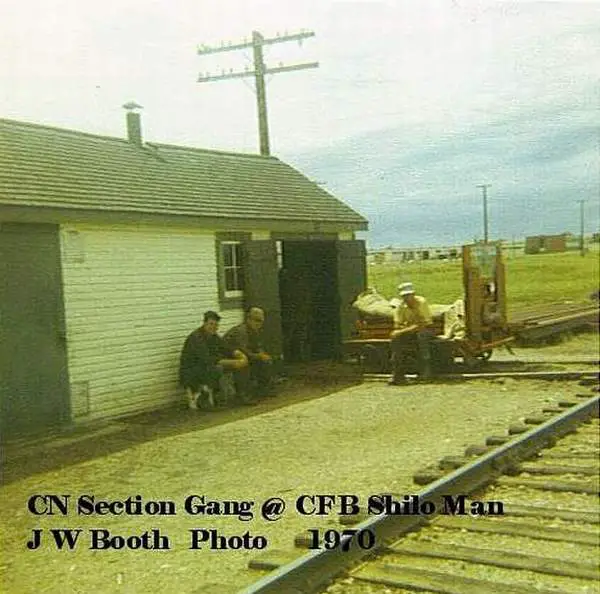 |
A CN Section gang on standby CFB Shilo Man, 1970 |
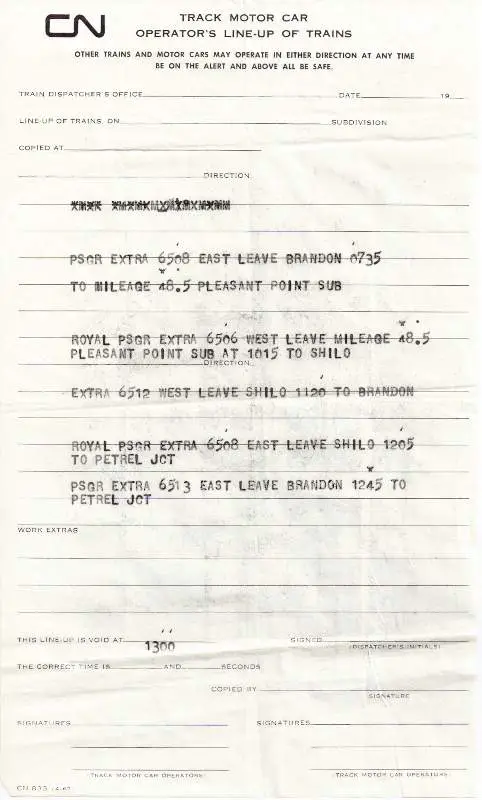 |
CN paperwork regarding the 1970 Royal Train in Manitoba |
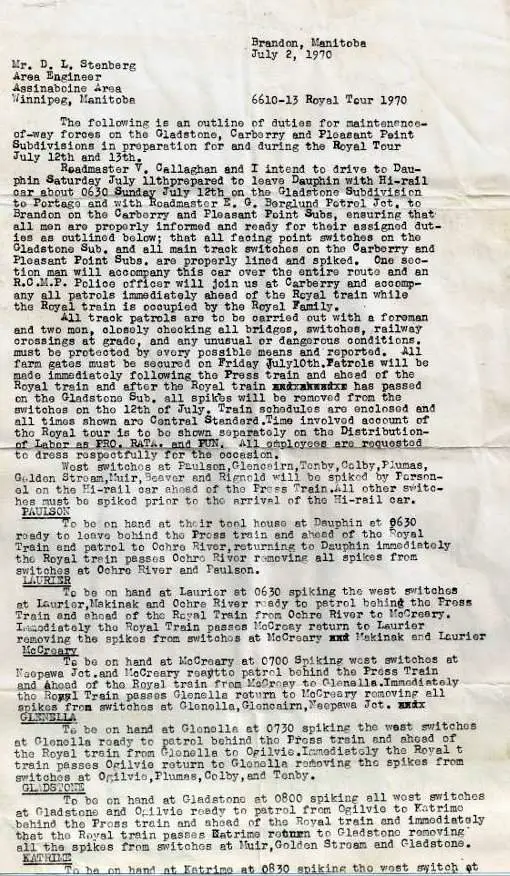 |
CN paperwork regarding the 1970 Royal Train in Manitoba |
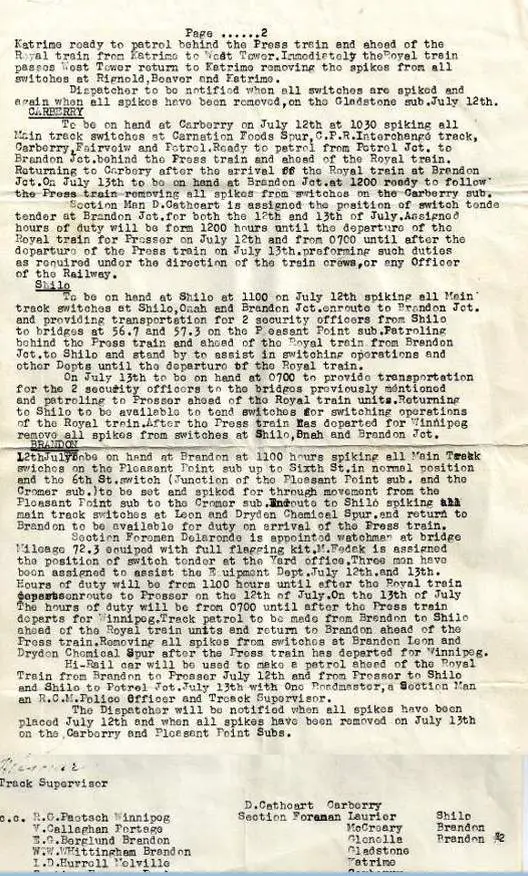 |
CN paperwork regarding the 1970 Royal Train in Manitoba |
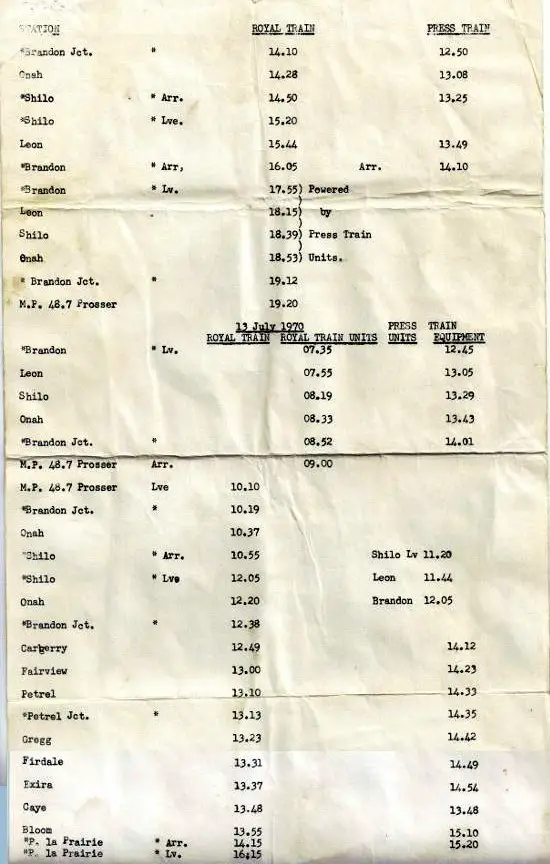 |
CN paperwork regarding the 1970 Royal Train in Manitoba |
| Some of the eork we were doing around here last summer.
(2014) We restored many of my CPR track signs the first was my CPR whistle
post that was salvaged from the Irricana Subdivision that you can see in
the first photo. Whistle posts were located on each side of railway public
crossings at grade,
one quarter of a mile or 1320 feet, these ones were unique to the CPR made from recycled boiler tubes, the "W" was an aluminum casting, they were painted silver with black on the side approaching the crossing. It was from her that the locomotive engineer would start whistling the two long, one short, and one long blasts of the whistle until the level crossing was occupied by the train. |
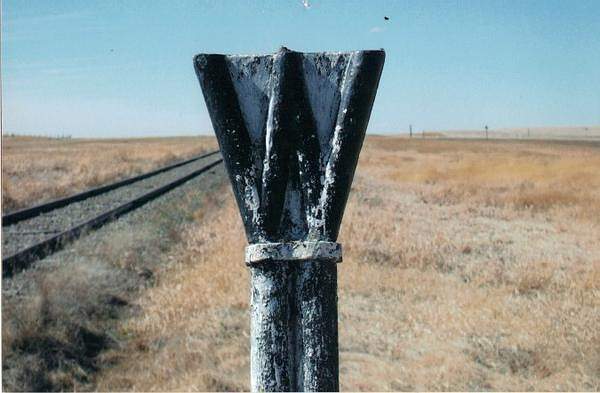 |
CPR whistle post |
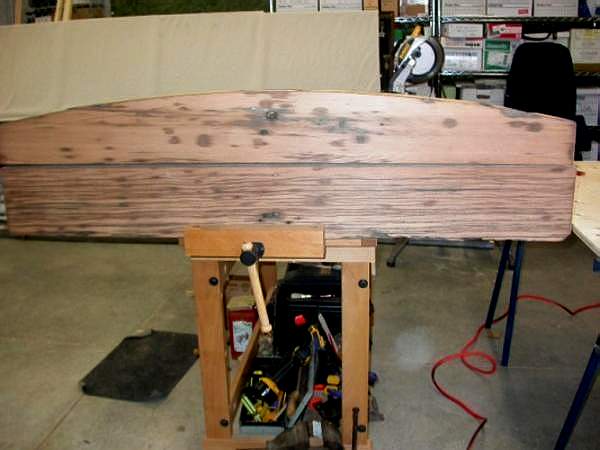 |
Next, we started restoration of the Kininvie mile board, CPR mile board's with their characteristic curved top were located 1 mile from sidings, this one was located 45 miles west of Medicine Hat, Alberta on the Brooks Subdivision, it was important to me as when I was taking my locomotive engineers training in April 1979. I was behind the throttle of a heavy grain train, and we had to take the siding here to clear an eastbound train, I applied a little too heavy automatic air brake application and as approaching the main track switch the amps were building up and there was a wheel slip that ended up putting the train into emergency. I had either torn out a knuckle, or worse, a drawbar, the head end brakeman walked back and found we had torn out a knuckle (coupler) 35 cars from the head end, the brakeman closed the angle cock from where the train had separated and we were able to get our air pressure back. Locomotives always carry spare knuckles, they are quite heavy so with our error recovered, we threw out a knuckle, and pulled ahead 35 lengths, so the brakeman could change out the knuckle cut in the air and walk back to the head end. We recharged the air on the rest of the train and pulled into the siding for the eastbound train that had arrived, not causing too much of a delay. This was the first coupler I had pulled out, but not the last in my 21 year career running locomotives. |
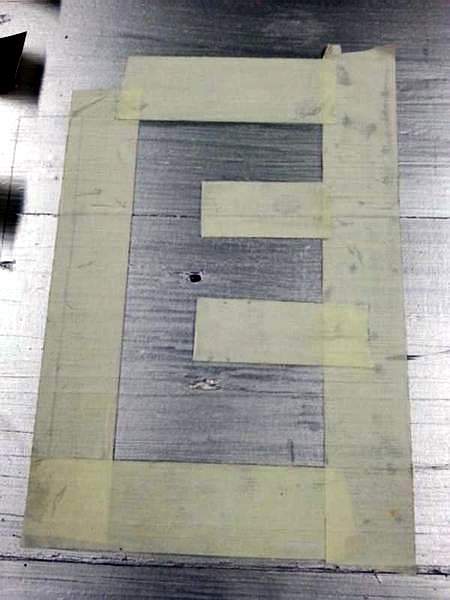 |
For years the Kininvie mile board had been knocked over and laid facedown along the right-of-way, after my accident, I told another engineer that I would like to get it. Going westward, one trip he stopped his train and with the help of his brakeman, they loaded the mile board and its 9 foot Cedar post on to the running board of their locomotive, and brought it out to my acreage. The weather over the years have taken its toll on the mile board, and the lettering was illegible, but it made a good restoration project, as you can see by the photos that I have attached. my caregiver, Helen did all the artwork for the lettering, and my friends Mike and Christopher did the physical work using CPR tools to dig the holes and put up the signs. |
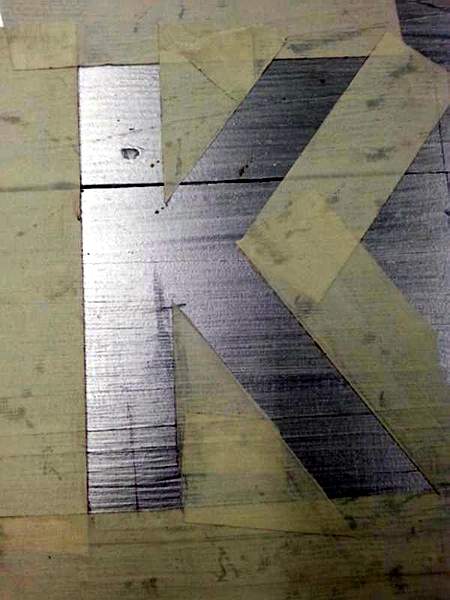 |
|
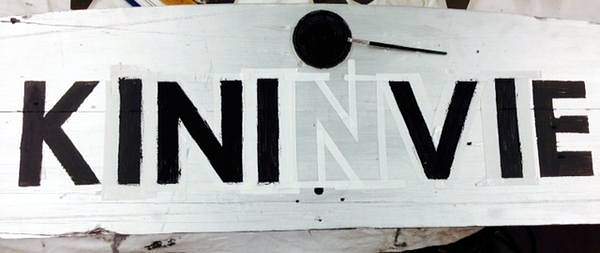 |
|
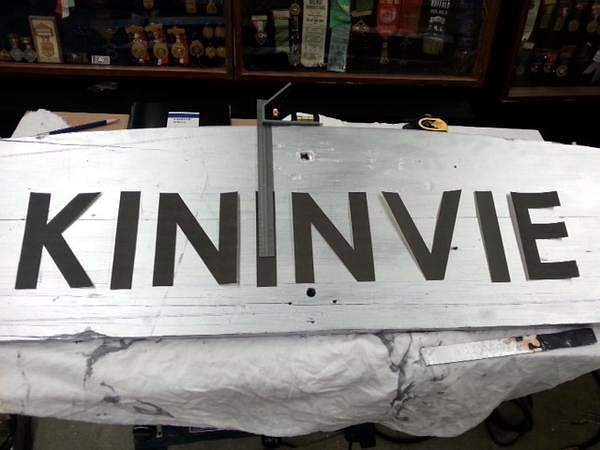 |
|
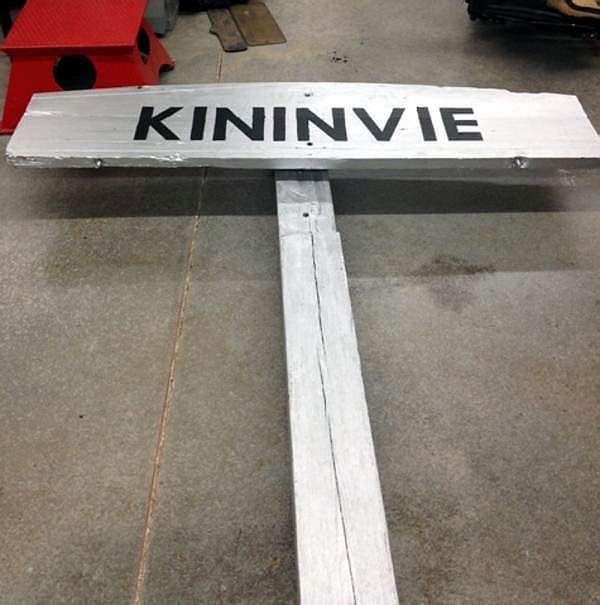 |
|
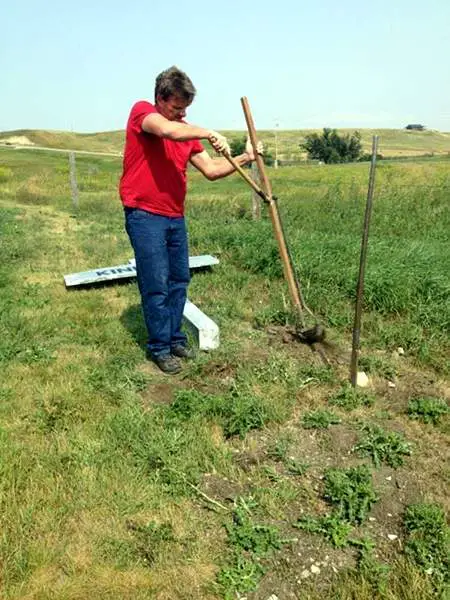 |
|
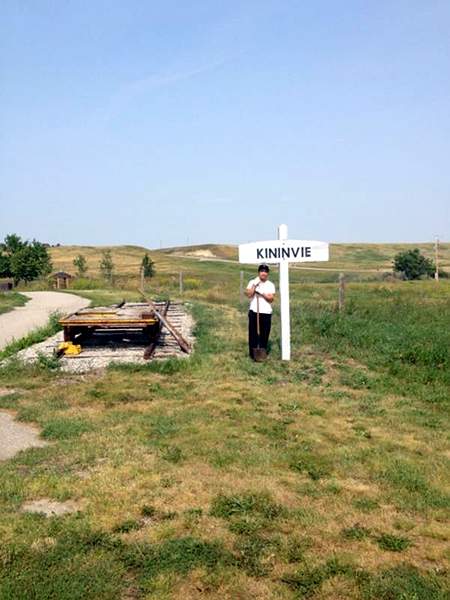 |
|
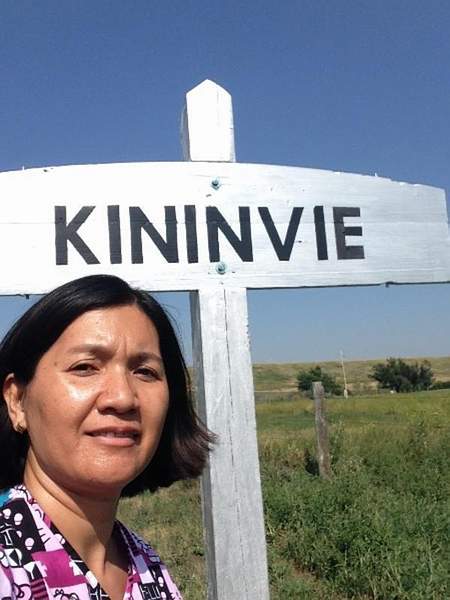 |
|
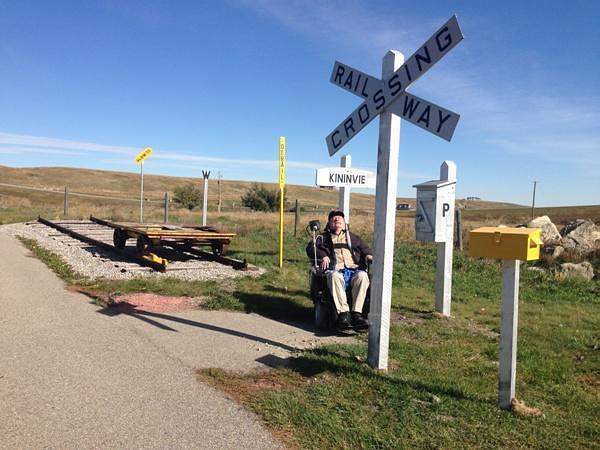 |
Other restoration projects included a yellow bill box These were
located at elevator backtracks and industrial plants
and were used by the shipper to place the way bills into, that the conductor would collect when cars were lifted. A trackside phone box these were located at the ends of sidings,
and could be used to contact the train dispatcher
Also restored was a 55 mph speed sign warning engineers of a slow curve up ahead, And my railway crossing sign. My speeder has been taken away for restoration and should be back in the fall. That's all for now. |
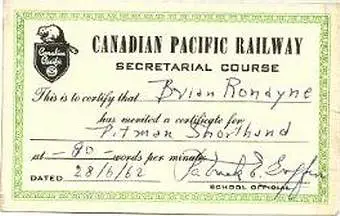 |
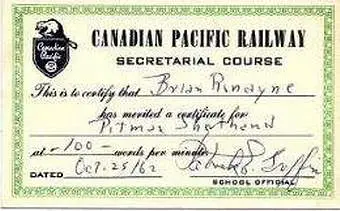 |
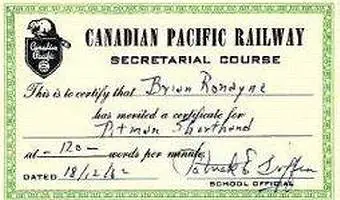 |
|
|
|
|
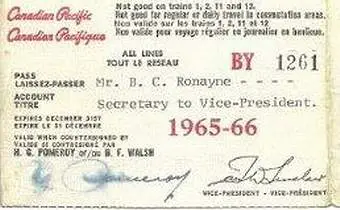 |
This submission was from Brian Ronayne
"I have many memories of my days working in Windsor Station, etc.
|
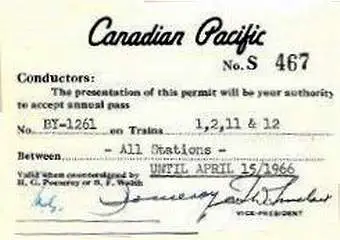 |
|
|
|
The
Memory Lane Railway Museum in Middleton, Nova Scotia.
The
only exclusive Dominion Atlantic Railway museum in the world
Welcome
to the DAR DPI
A web
community initiative intent on digitally preserving
the history
of the Dominion Atlantic Railway
| Privacy Policy for http://yourrailwaypictures.com/
If you require any more information or have any questions about our privacy policy, please feel free to contact us by email at john@summervillens.ca At http://yourrailwaypictures.com/, the privacy of our visitors is of extreme importance to us. This privacy policy document outlines the types of personal information is received and collected by http://yourrailwaypictures.com/ and how it is used. Log Files
Cookies and Web Beacons
DoubleClick DART Cookie
Some of our advertising partners may use cookies and web beacons on
our site. Our advertising partners include ....
These third-party ad servers or ad networks use technology to the advertisements and links that appear on http://yourrailwaypictures.com/ send directly to your browsers. They automatically receive your IP address when this occurs. Other technologies ( such as cookies, JavaScript, or Web Beacons ) may also be used by the third-party ad networks to measure the effectiveness of their advertisements and / or to personalize the advertising content that you see. http://yourrailwaypictures.com/ has no access to or control over these cookies that are used by third-party advertisers. You should consult the respective privacy policies of these third-party ad servers for more detailed information on their practices as well as for instructions about how to opt-out of certain practices. http://yourrailwaypictures.com/'s privacy policy does not apply to, and we cannot control the activities of, such other advertisers or web sites. If you wish to disable cookies, you may do so through your individual browser options. More detailed information about cookie management with specific web browsers can be found at the browsers' respective websites. |